We have given these Accountancy Class 12 Important Questions and Answers Chapter 6 Accounting for Share Capital to solve different types of questions in the exam. Go through these Class 12 Accountancy Chapter 6 Accounting for Share Capital Class 12 Important Questions and Answers Solutions & Previous Year Questions to score good marks in the board examination.
Accounting for Share Capital Important Questions Class 12 Accountancy Chapter 6
Question 1.
What is meant by ‘issued capital’? (Delhi 2019)
Answer:
It means such capital as the company issues from time-to-time for subscription.
Question 2.
What is meant by ‘reserve capital’? (All India 2019)
Answer:
Part of capital of a company which is called-up only on winding up is called ‘reserve capital’.
Question 3.
Is ‘reserve capital’ a part of ‘unsubscribed capital’ or ‘uncalled capital’? (CBSE 2018)
Answer:
Reserve capital is a part of uncalled capital.
![]()
Question 4.
Differentiate between issued share capital and subscribed share capital. (All India (C) 2016)
Answer:
Difference between issued capital and subscribed share capital is
Subscribed Share Capital:
It means such part of the capital which is for the time being subscribed by the members of a company.
Issued Share Capital:
It means such capital as the company issues from time-to-time for subscription.
Question 5.
What is the name given to the part of capital of a company which is called-up only on winding up? (Delhi (C) 2015: All India 2015,2011 Modified)
Answer:
Part of capital of a company which is called-up only on winding up is called ‘reserve capital’.
Question 6.
D Ltd invited applications for issuing 10,00,000 equity shares of ₹ 10 each. The public applied for 8,55,000 shares. Can the company proceed for the allotment of shares? Give reason in support of your answer. (All India 2014)
Answer:
No, the shares cannot be allotted because subscribed shares are less than 90%, i.e. as per SEBI guidelines, a company must receive a minimum of 90% of subscription.
Question 7.
What is meant by paid-up capital? (All India (C) 2014)
Answer:
It is the amount that the shareholder has paid and the company has received against the amount called-up against the shares towards share capital.
Question 8.
What is meant by authorised capital of a company? (All India (C) 2014; Foreign 2011)
Answer:
According to Section 2 (8) of the Companies Act, 2013, ‘authorised capital’ means such capital as is authorised by the memorandum of a company to be the maximum amount of share capital of a company.
Question 9.
Give the meaning of called-up capital. (All India 2011)
Answer:
Called-up capital means such part of the capital, which has been called for payment. Thus, it means the amount of nominal (face) value called up by the company to be paid by the shareholders towards the share capital.
Question 10.
What are preliminary expenses? (Delhi 2010)
Answer:
The expenses incurred in the promotion and formation of the company are known as preliminary expenses, such as registration fee paid to registrar of the companies, stamp duty, legal expenses, expenses regarding preparation and issue of prospectus, etc.
Question 11.
What is meant by ‘capital reserve’? (All India 2010)
Answer:
‘Capital reserve’ is the reserve which is not free for distribution as dividend. It is mandatory to create capital reserve in case of capital profits earned by the company.
Question 12.
What is meant by a ‘share’? Give any two differences between ‘preference shares’ and ‘equity shares’. (CBSE 2018)
Answer:
According to Section 2(84) of the Companies Act, 2013, “Share means a share in the capital of a company and includes share”. It is the unit into which the capital of a company is divided.
| Basis | Preference Shares | Equity Shares |
| Dividend Rate | Preference shares are paid dividend at a fixed rate. | The rate of dividend may vary from year to year and on the availability of profits. |
| Redemption | They can be redeemed as provided by the articles and terms of issue. | They cannot be redeemed except under a scheme involving reduction of capital. |
Question 13.
What is meant by private placement of shares? (All India 2019: Compartment 2018)
Answer:
Private placement of shares means selling of shares to a relatively small number of selected investors. Private placement is the opposite of a public issue, in which securities are made available for sale in the open market.
Question 14.
What is meant by employee stock option plan? (Delhi 2019: All India (C) 2016)
Answer:
Employees stock option plan is a plan whereby an option is given by the company to its whole time directors, officers and employees to purchase or acquire at a future date, a specified number of shares at a pre-determined price, which is usually lower than the market price.
Question 15.
On 28th February, 2016 the first call of ₹ 2 per share became due on 50,000 equity shares alloted by Kumar Ltd. Komal a holder of 1,000 shares did not pay the first call money. Kovil a holder of 750 shares paid the second and final call of ₹ 4 per share along with the first call.
Pass the necessary journal entry for the amount received by opening calls-in-arrears and calls-in -advance account in the books of the company. (All India 2016)
Answer:
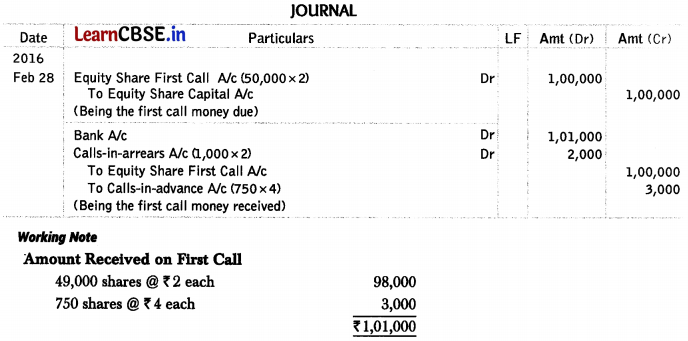
Question 16.
On 1st January, 2016 the first call of ₹ 3 per share became due on 1,00,000 equity shares issued by Kamini Ltd. Karan, a holder of 500 shares did not pay the first call money. Arjun, a shareholder holding 1,000 shares paid the second and final call of ₹ 5 per share alongwith the first call.
Pass the necessary journal entry for the amount received by opening ‘calls-in-arrears’ and ‘calls-in-advance’ account in the books of the company. (Delhi 2016)
Answer:
Solve as’Q no. 3 on page
Calls-in-arrears = ₹ 1,500; Calls-in-advance = ₹ 5,000
Question 17.
Nirman Ltd issued 50,000 equity shares of ₹ 10 each. The amount was payable as follows
On application : ₹ 3 per share
On allotment : ₹ 2 per share
On first and final call : Balance
Applications for 45,000 shares were received and shares were allotted to all the applicants, Pooja, to whom 500 shares were allotted, paid her entire share money at the time of allotment, whereas Kundan did not pay the first and final call on his 300 shares. What amount will be received at the time of making the first and final call. (All Inda 2015 Modified)
Answer:
Calculation of amount received at the time of making first and final call.
Amount due at the time of first and final call ’ (45,000 – 500) x 5 = 2,22,500
(-) Calls-in-aiTears (300 x 5) = (1,500)
= ₹ 2,21,000
Question 18.
Joy Ltd issued 1,00,000 equity shares of ₹ 10 each. The amount was payable as follows
On application : ₹ 3 per share
On allotment : ₹ 4 per share
On first and final call : Balance
Applications for 95,000 shares were received and shares were allotted to all the applicants. Sonam, to whom 500 shares were allotted, failed to pay the allotment money and Gautam paid his entire amount due including the amount due on first and final call on the 750 shares allotted to him along with allotment. What amount will be received at the time of allotment? (Delhi 2015 Modified)
Answer:
Calculation of amount received at the time of allotment
Amount due on allotment (95,000 x 4) = 3,80,000
(-) CaUs-in-arrears (500 x 4) = (2,000)
(+) Calls-in-advance (750 x 3) = 2,250
= ₹ 3,80,250
![]()
Question 19.
What is meant by over subscription? (All India (C) 2014)
Answer:
When the number of shares applied for is more than the number of shares offered for subscription, the shares are said to be over subscribed.
Question 20.
What is meant by ‘under subscription’? (All India 2014)
Answer:
Under subscription means that number of shares applied for is less than the number of shares issued.
Question 21.
Give any one purpose for which the amount received as ‘securities premium reserve’ may be utilised. (Delhi; All India (C) 2014)
Answer:
Securities premium reserve can be utilised in writing-off preliminary expenses of the company.
Question 22.
What is meant by ‘calls-in-arrears’? (All India 2013)
Answer:
If shareholders make default in paying the money due on allotment or any call, the money not so paid is called calls-in-arrears.
Question 23.
What rate of interest the company pays on calls-in-advance, if it has not prepared its own Articles of Association? (Delhi 2013)
Answer:
As per Table F of the Companies Act, interest on calls-in-advance is payable @ 12% per annum by the company.
Question 24.
What is meant by ‘securities premium reserve’? (Delhi 2013)
Answer:
A company can issue its shares at more than its face value. Excess of issue price of shares over its face value is termed as securities premium reserve.
Question 25.
What is meant by ‘calls-in-advance’? (All India 2012)
Answer:
Calls-in-advance means the amount paid by shareholders is in excess of the amount due from them. The company may receive calls-in-advance if the articles permit. It is shown as a current liability in the balance sheet.
Question 26.
State the steps other than rejecting applications that a company can take in case of over subscription. (Delhi (C) 2011)
Answer:
The steps other than rejecting applications that a company can take in case of over subscription are
(i) All applicants are allotted shares on pro-rata basis.
(ii) Some applicants are allotted shares in full and some are allotted shares on pro-rata basis.
Question 27.
Can securities premium reserve be used as working capital? Give reason in support of your answer. (All India 2011)
Answer:
Securities premium reserve cannot be used as working capital.
According to Section 52 (2) of the Companies Act, 2013, the securities premium reserve can be applied only for the following purposes
- Issuing fully paid bonus shares to the members.
- Writing-off the preliminary expenses of the company.
- Writing-off the expenses on issue of shares, commission paid on any issue of shares or debentures of the company and discount allowed on any issue of shares and debentures.
- Providing for the premium payable on the redemption of redeemable preference shares or debentures of the company.
- In purchasing its own shares (buy back).
Question 28.
What is meant by pro-rata allotment of shares? (All India 2010)
Answer:
In the case of over subscription, it is not possible to allot shares to all applicants. Applicants may be allotted less number of shares than they have applied for. This type of allotment of shares is known as pro-rata allotment of shares, e.g. If company allots 50,000 shares to applicants of 75,000 shares, it is pro-rata allotment in proportion of 2 : 3.
Question 29.
What is meant by issue of shares at par? (All India 2010)
Answer:
When shares are issued at the face value, the shares are said to have been issued at par.
Question 30.
What is meant by ‘over subscription’ of shares? With the help of an example, briefly explain the alternatives available for allotment of shares in case of over subscription. (Delhi 2017; All India 2019)
Answer:
Refer to Q. no. 7 on page 275 and Q. no 26 on page 281.
Question 31.
“WX Ltd’ was registered with an authorised capital of 2,00,000 equity shares of ₹ 10 each. The company offered 1,50,000 shares to the public for subscription 1,45,000 shares were subscribed. All calls were made and were duly received except the final call of ₹ 3 on 5,000 shares.
Present the share capital of the company as per the provisions of Schedule III, Part I of the Companies Act, 2013. (All India 2019)
Answer:
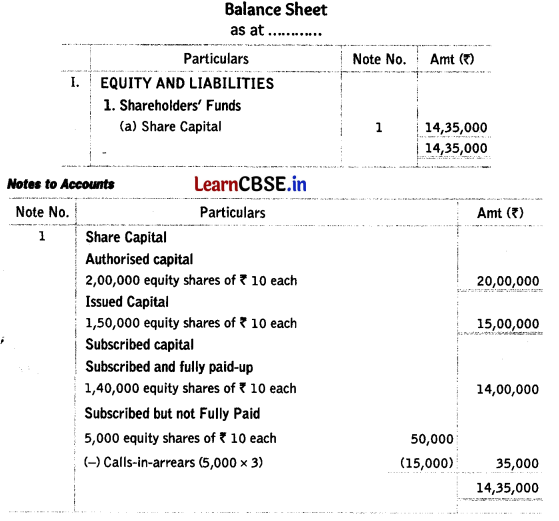
Question 32.
JN Ltd were registered with an authorised capital of 2,00,000 equity shares of ₹ 100 each. The-company offered to the public for subscription 1,00,000 shares. Applications for 1,50,000 shares were received and allotment was made to all the applicants on pro-rata basis. All calls were made and were duly received except the second and final call of ₹ 4,000. The amount payable on second and final call was ₹ 20 per share.
Present the share capital in the balance sheet of the company as per Schedule III, Part I of the Companies Act, 2013. (All India 2019)
Answer:
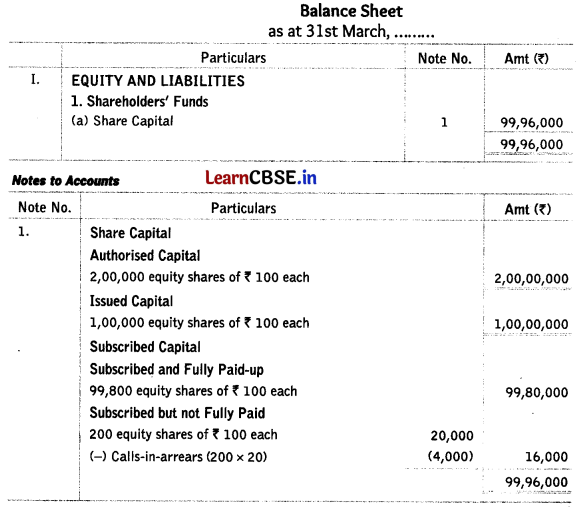
![]()
Question 33.
Willow Ltd was registered with an authorised capital of ₹ 10,00,000 divided into 1,00,000 equity shares of ₹ 10 each. The company offered 80,000 shares for subscription to the public, out of which 75,000 shares were subscribed. All amounts were received except the final call of ₹ 2 per share on 3,000 shares. Fill in the missing figures in the balance sheet of Willow Ltd as per the provisions of Schedule III, Part I of the Companies Act, 2013.
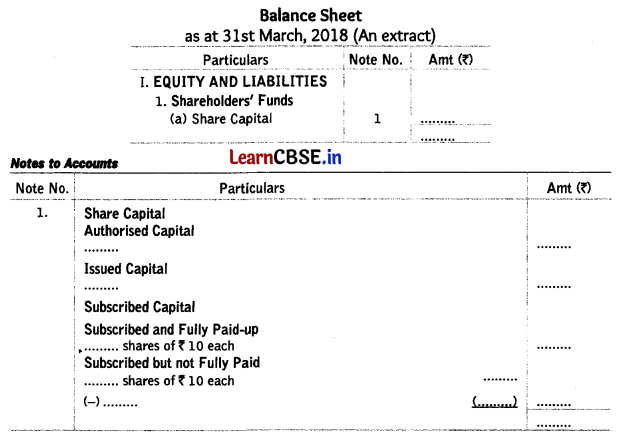
Answer:
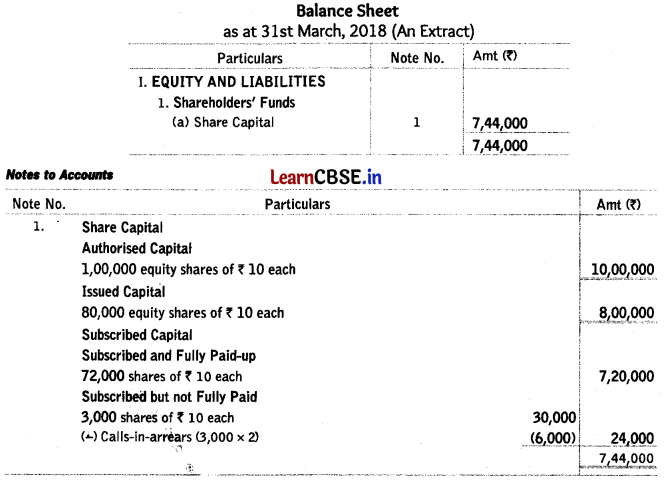
Question 34.
NK Ltd, a truck manufacturing company, is registered with an authorised capital of ₹ 1,00,00,000 divided into equity shares of ₹ 100 each. The subscribed and paid-up capital of the company is ₹ 50,00,000. To meet the capital expenditure requirements of the project, the company offered 20,000 shares to the public for subscription. The shares were fully subscribed and paid.
Present the share capital in the balance sheet of the company as per the provisions of Schedule III of the Companies Act, 2013. (CB8E 2018 Modified)
Answer:
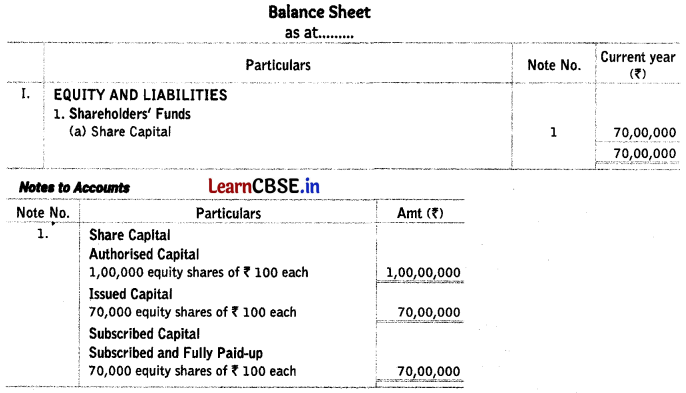
Question 35.
Navnirman Ltd. issued 4,00,000 equity shares of ₹ 10 each at par. The amount per share was payable as follows ₹ 3 on application; ₹ 2 on allotment; ₹ 2 on first call and ₹ 3 on final call. The issue was fully subscribed and the shares were allotted fully to all the applicants. All calls were made. Mahi, a shareholder holding 6,000 shares paid the final call money alongwith the first call. Shrey holding 700 shares did not pay the first call on the due date. Shrey paid the first call alongwith the final call. The accountant of the company had correctly passed the entries till receipt of allotment money. After that the following entries were left incomplete by him. Complete these entries, (comportment 2018)
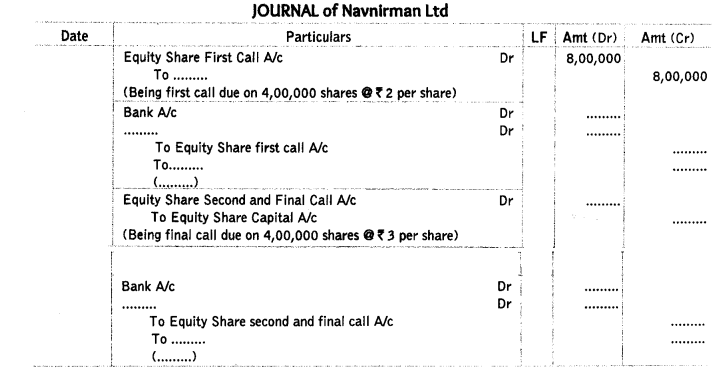
Answer:
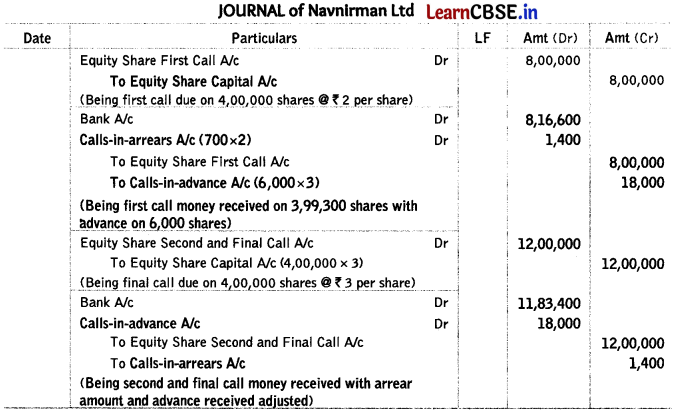
Question 36.
K Ltd took over the assets of ₹ 16,00,000 and liabilities of ₹ 5,00,000 of P Ltd for a purchase consideration of ₹ 13,68,500. ₹ 25,500 were paid by issuing a promissory note in favour of P Ltd payable after two months and the balance was paid by issue of equity shares of ₹ 100 each at a premium of 25%. Pass necessary journal entries for the above transactions in the hooks of K Ltd. (All India 2016)
Answer:
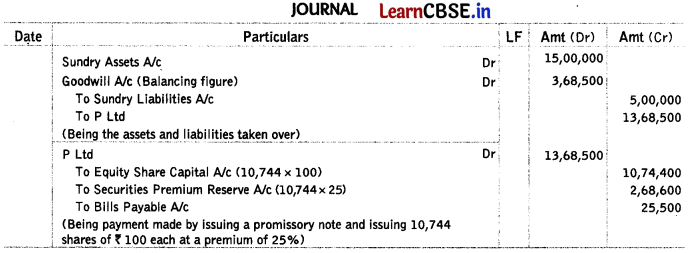
Working Notes:
Number of shares Issued = \(\frac{13,43,000(13,68,500-25,500)}{125(100+25)}\) = 10,744 shares
Question 36.
Sandesh Ltd took over the assets of ₹ 7,00,000 and liabilities of ₹ 2,00,000 from Sanchar Ltd for a purchase consideration of ₹ 4,59,500, ₹ 8,500 were paid by accepting a draft in favour of Sanchar Ltd payable after three months and the balance was paid by issue of equity shares of ₹ 10 each at a premium of 10% in favour of Sanchar Ltd. Pass necessary journal entries for the above transactions in the books of Sandesh Ltd. (Delhi 2016)
Answer:
Solve as Q no. 24 on page 280.
Capital Reserve = ₹ 40,500
Number of equity shares issued = 41,000
Question 37.
Guru Ltd invited applications for issuing 5,00,000 equity shares of ₹ 10 each at a premium of ₹ 5 per share. Because of favourable market conditions the issue was over subscribed and applications for 15,00,000 shares were received.
Suggest the alternatives available to the Board of Directors for the allotment of shares. (All India 2015)
Answer:
In case of over subscription of shares, the Board of Directors has the following alternatives
(i) Excess application fully rejected and money refunded.
(ii) Excels application fully adjusted towards allotment and calls.
(iii) Excess applications partly rejected and partly adjusted towards further calls.
Question 38.
State any three purposes other than ‘issue of bonus shares’ for which securities premium can be utilised. (All India; Delhi 2015)
Or
State any three purposes other than “buy-back of shares’ for which securities premium can be utilised. (Foreign 2015)
Or
Securities premium can also be utilised for three other purposes besides (i) issuing fully paid bonus shares and (ii) “buy-back of shares’. State other purposes. (Delhi 2015)
Answer:
According to Section 52 (2) of the Companies Act, 2013, the securities premium reserve may be applied for the following purposes
(i) To write off preliminary expenses of the company.
(ii) To write off the expenses of or the commission paid or discount allowed on any issue of shares or debentures of the company.
(iii) To provide for the premium payable on the redemption of any redeemable preference shares or of any debentures of the company.
Question 39.
‘Tractors India Ltd’ is registered with an authorised capital of ₹ 10,00,000 divided into 1,00,000 equity shares of ₹ 10 each. The company issued 50,000 equity shares at a premium of ₹ 5 per share. ₹ 2 per share were payable with application, ₹ 8 per share including premium on allotment and the balance amount on first and final call. The issue was fully subscribed and all the amount due was received except the first and final call money on 500 shares allotted to Balaram.
Present the ‘share capital’ in the balance sheet of ‘Tractors India Ltd’ as per Schedule III, Part I of the Companies Act, 2013. Also prepare notes to accounts for the same. (Delhi 2015)
Answer:
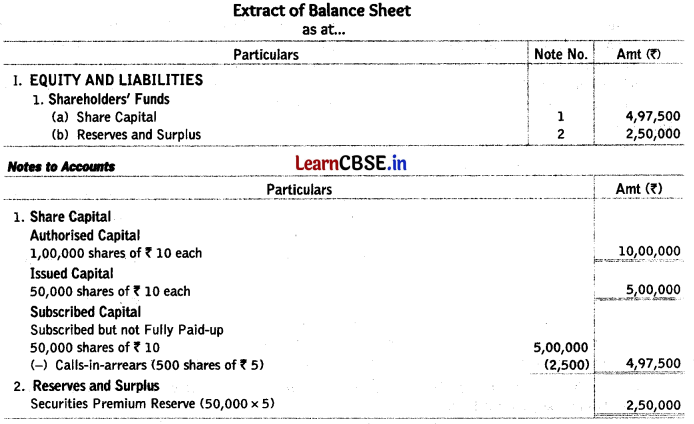
Question 40.
Sundram Ltd purchased furniture for ₹ 3,00,000 from Ravindram Ltd, ₹ 1,00,000 were paid by drawing a promissory note in favour of Ravindram Ltd. The balance was paid by issue of equity shares of? 10 each at a premium of 25%. Pass journal entries in the books of Sundram Ltd. (All India 2012)
Answer:

Working Note:
Number of Shares to be Issued to Ravindram Ltd = \(\frac{2,00,000}{10+2.5}\) = 16,000 shares
Question 41.
Z Ltd purchased furniture costing ₹ 2,20,000 from CD Ltd. The payment was to be made by issuing of 9% preference share of ₹ 100 each at a premium of ₹ 10 per share. Pass necessary journal entries in the books of Z Ltd. (Delhi 2011)
Answer:

Working Note:
Number of Shares to be Issued to CD Ltd = \(\frac{2,20,000}{100+10}\) = 2,000 shares
![]()
Question 42.
DN Ltd issued 50,000 shares of ₹ 10 each payable as ₹ 2 per share on application, ₹ 3 per share on allotment and ₹ 5 on first and final call. Applications were received for 70,000 shares. It was decided that
(i) Refuse allotment to the applicants of 10,000 shares.
(ii) Allot 20,000 shares to Mohan who had applied for similar number.
(iii) Allot the remaining shares on pro-rata basis.
Mohan failed to pay the allotment money and Sohan who belonged to the category (iii) and was allotted 3,000 shares paid both the calls with allotment. Calculate the amount received on allotment. (All India: Delhi 2010 Modified)
Answer:
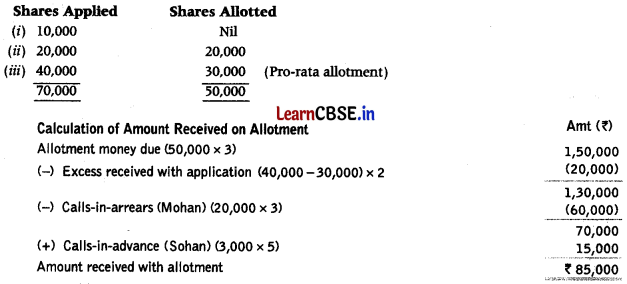
Question 43.
Pass necessary journal entries for the following transactions in the books of Gopal Ltd
(i) Purchased furniture for ₹ 2,50,000 from M/s Furniture Mart. The payment to M/s Furniture Mart was made by issuing equity shares of ₹ 10 each at a premium of 25%.
(ii) Purchased a running business from Aman Ltd for a sum of ₹ 15,00,000. The payment of 12,00,000 was made by issue of fully paid equity shares of ₹ 10 each and balance by a bank draft. The assets and liabilities consisted of the following: plant ₹ 3,50,000; stock ₹ 4,50,000; land and building ₹ 6,00,000; sundry creditors ₹ 1,00,000. (All India 2014)
Answer:
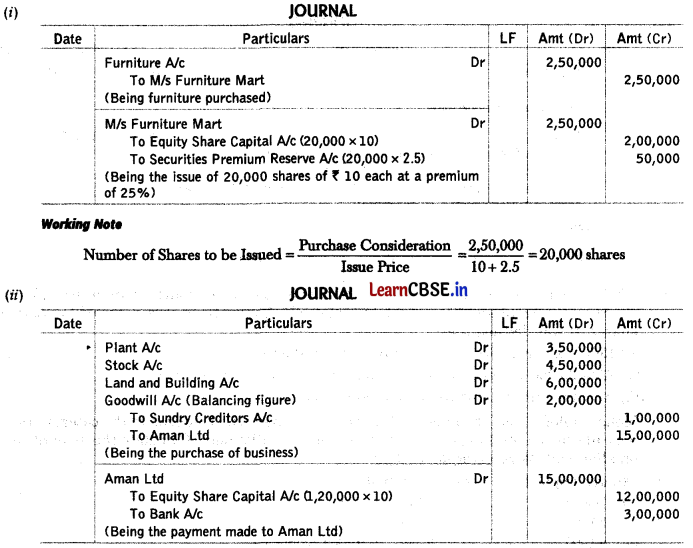
Working Note:
Number of Shares to be Issued = \(\frac{\text { Purchase Consideration }}{\text { Issue Price }}=\frac{12,00,000}{10}\) = 1,20,000 shares
Question 44.
1st April, 2012 Vivek Ltd was formed with an authorised capital of ₹ 1,00,00,000 divided into 2,00,000 equity shares of ₹ 50 each. The company issued prospectus inviting applications for 1,80,000 shares. The issue price was payable as under
On application : ₹ 15
On allotment : ₹ 20
On call : Balance amount
The issue was fully subscribed and the company allotted shares to all the applicants. The company did not make the call during the year.
Show the following:
(i) Share capital in the balance sheet of the company as per Schedule III, Part I of the Companies Act, 2013.
(ii) Also prepare ‘Notes to accounts’ for the same. (Delhi 2014)
Answer:
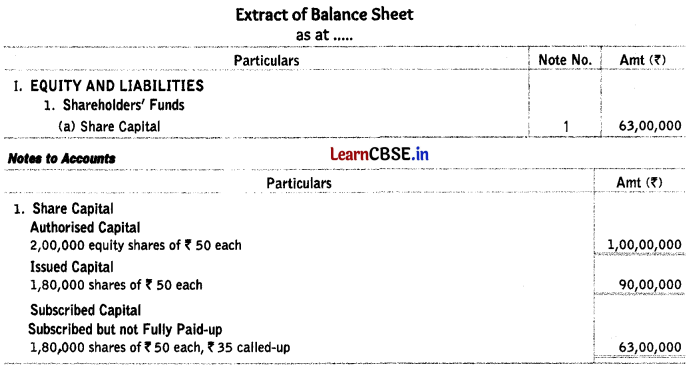
Question 45.
Rajan Ltd purchased a running business from Vikas Ltd for a sum of ₹ 2,50,000 payable as ₹ 2,20,000 in fully paid equity shares of ₹ 10 each and balance by a bank draft. The assets and liabilities consisted of the following
Plant and machinery ₹ 90,000; building ₹ 90,000; sundry debtors ₹ 30,000; stock ₹ 50,000; cash ₹ 20,000; sundry creditors ₹ 20,000. (Delhi 2014)
Answer:
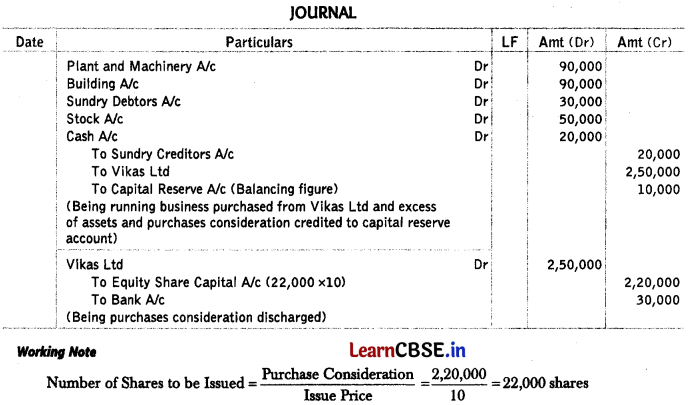
Question 46.
Nikhil Ltd purchased a running business from Sonia Ltd for a sum of ₹ 22,00,000 by issuing 20,000 fully paid equity shares of ₹ 100 each at a premium of 10%. The assets and liabilities consisted of the following
Machinery ₹ 7,00,000; debtors ₹ 2,50,000; stock ₹ 5,00,000; building ₹ 11,50,000 and bills payable ₹ 2,50,000.
Pass necessary journal entries in the books of Nikhil Ltd for the above transactions. (All India 2013)
Answer:
For journal entry relating to purchases of business, solve as Q no. 34 on page 285.

Working Note:
Number of Equity Shares Issued = \(\frac{22,00,000}{110}\) = 20,000
Question 47.
The authorised capital of Suhas Ltd is ₹ 50,00,000 divided into 25,000 shares of ₹ 200 each. Out of these, the company issued 12,000 shares of ₹ 200 each at a premium of 10%. The amount per share was payable as follows
₹ 60 on application
₹ 60 on allotment (including premium)
₹ 30 on first call and balance on final call.
Public applied for 11,000 shares. All the money was duly received.
Prepare an extract of balance sheet of Suhas Ltd as per Revised Schedule III, Part I of the Companies Act, 2013 disclosing the above information. Also prepare ‘Notes to accounts’ for the same. (All India 2013)
Answer:
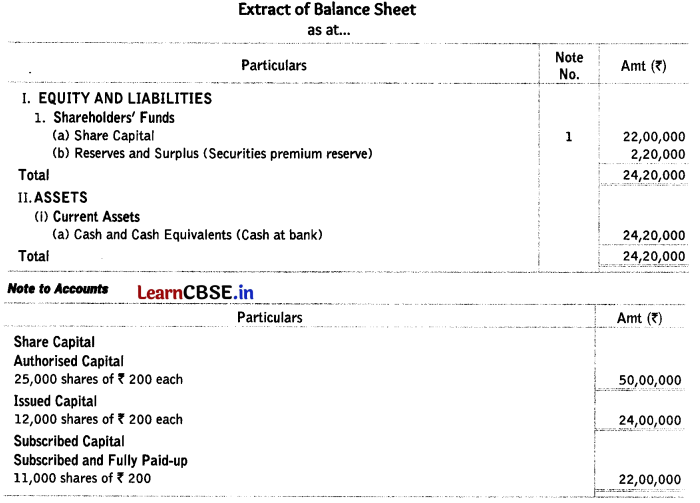
Question 48.
Z Ltd forfeited 1,000 equity shares of ₹ 10 each for the non-payment of the first call of ₹ 2 per share. The final call of ₹ 3 per share was yet to be made. Calculate the maximum amount of discount at which these shares can be re-issued. (All India 2017)
Answer:
The maximum amount of discount allowed on the re-issue of forfeited shares must not exceed the amount forfeited on re-issued shares. In this case, the maximum amount of discount at which shares can be re-issued is (1,000 x 5) = ₹ 5,000.
Question 49.
Y Ltd forfeited 100 equity shares of ₹ 10 each for the non-payment of first call of ₹ 2 per share. The final call of ₹ 2 per share was yet to be made. Calculate the maximum amount of discount at which these shares can be re-issued. (Delhi 2017)
Answer:
Solve as Q no. 1 on page 288.
Maximum Discount at which shares can be re-issued (100 x 6) = ₹ 600
Question 50.
Give the meaning of forfeiture of shares. (All India 2014 (C), 2010; Foreign 2015)
Answer:
Forfeiture of shares means cancellation of shares and seizure of the amount received from the defaulting shareholders, whose shares have been forfeited. Upon forfeiture, the name of original shareholder must be removed from the register of members. Forfeiture results in reduction of share capital.
Question 51.
A Ltd forfeited 100 equity shares of? 10 each issued at premium of 20% for the non-payment of final call of ₹ 5 including premium. State the maximum amount of discount at which these shares can be re-issued. All India 2014
Answer:
Maximum amount of discount that can be allowed at the time of re-issue is the amount forfeited on re-issued shares, i.e. (100 × 7) = ₹ 700.
![]()
Question 52.
What is the maximum amount of discount at which forfeited shares can be re-issued? (Delhi 2014 Modified)
Answer:
When forfeited shares are re-issued at a discount, the discount cannot exceed the amount forfeited on re-issued shares.
Question 53
What is meant by ‘forfeiture of shares’? When does ‘gain on forfeited shares’ arise and when is it transferred to capital reserve? (All India 2019)
Answer:
‘Forfeiture of shares’ refer to Q. no 3 on page 288.
When forfeited shares are re-issued at discount, gain on forfeited shares arises. The balance left in the share forfeited account after the re-issue is transferred to the capital reserve account.
Question 54.
Janta Ltd had an authorised capital of 2,00,000 equity shares of ₹ 10 each. The company offered to the public for subscription 1,00,000 shares. Applications were received for 97,000 shares. The amount was payable as follows on application was ₹ 2 per share, ₹ 4 was payable each on allotment and first and final call. A shareholder holding 600 shares failed to pay the allotment money. His shares were forfeited. The company did not make the first and final call.
Present the share capital in the balance sheet of the company as per Schedule III of the Companies Act, 2013. Also prepare notes to accounts, (comportment 2018)
Answer:
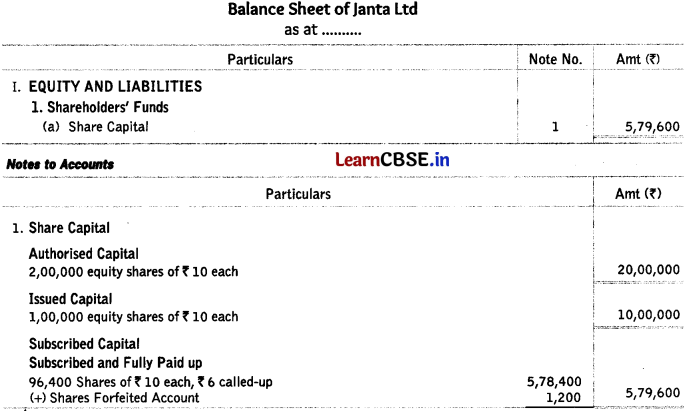
Question 55.
Sajag Ltd has an authorised capital of? 30,00,000 divided into equity shares of ₹ 30 each. The compnay invited applications for issuing 70,000 shares. Applications for 68,000 shares were received.
All calls were made and were duly received except the final call of? 10 per share on 5,000 shares. These shares were forfeited.
(i) Present the share capital in the balance sheet of the company as per Schedule III of the Companies Act, 2013.
(ii) Also prepare ‘Notes to accounts’ for the same. (All India (C) 2016)
Answer:
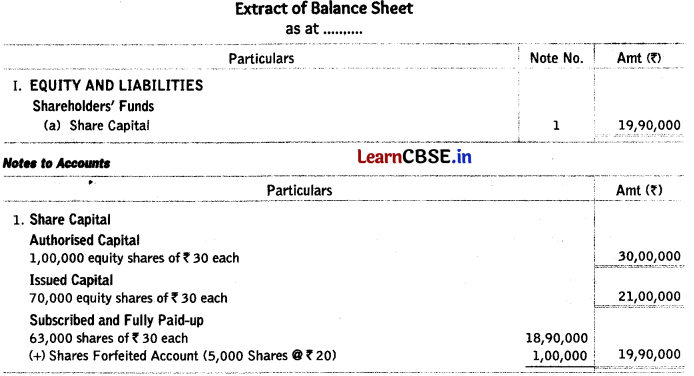
Question 55.
Samprag Ltd has an authorised capital of ₹ 20,00,000 divided into equity shares of? 10 each. The company invited applications for issuing 60,000 shares. Applications for 58,000 shares were received.
All calls were made and were duly received except the final call of ₹ 3 as share on 2,000 shares. These shares were forfeited.
(i) Present the share capital in the balance sheet of the company as per Schedule III of the Companies Act, 2013.
(ii) Also prepare ‘Notes to accounts’ for the same. (Delhi (C) 2016)
Answer:
Solve as Q no. 8 on page 290. Share capital = ₹ 5,74,000
Question 56.
‘Suvidha Ltd’ is registered with an authorised capital of ₹ 10,00,00,000 divided into 10,00,000 equity shares of ₹ 100 each. The company issued 1,00,000 shares for public subscription. A shareholder holding 100 shares, faded to pay the final call of ₹ 20 per share. His shares were forfeited. The forfeited shares were re-issued at ₹ 90 per share as fully paid-up.
Present the share capital in the balance sheet of the company as per Schedule III, Part I of the Companies Act, 2013. Also prepare notes to accounts. (All India 2015)
Answer:
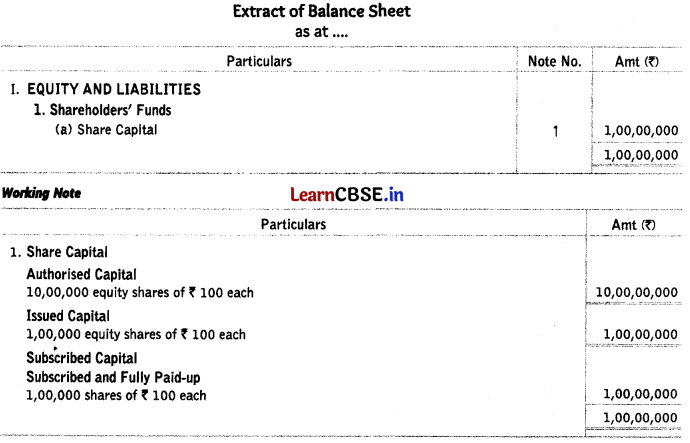
Question 57.
‘India Auto Ltd’ is registered with an authorised capital of ₹ 7,00,00,000 divided into 7,00,000 shares of ₹ 100 each. The company issued 50,000 shares to the vendor for building purchased and 2,00,000 shares were issued to the public. The amount was payable as follows
On application and allotment : ₹ 20 per share
On first call : ₹ 50 per share
On second and final call : Balance
All calls were made and were duly received except on 100 shares held by Rajani, who failed to pay the second and final call. Her shares were forfeited.
Present the ‘share capital’ in the balance sheet of the company as per Schedule III, Part I of the Companies Act, 2013. Also prepare ‘notes to accounts’. (All India 2015)
Answer:
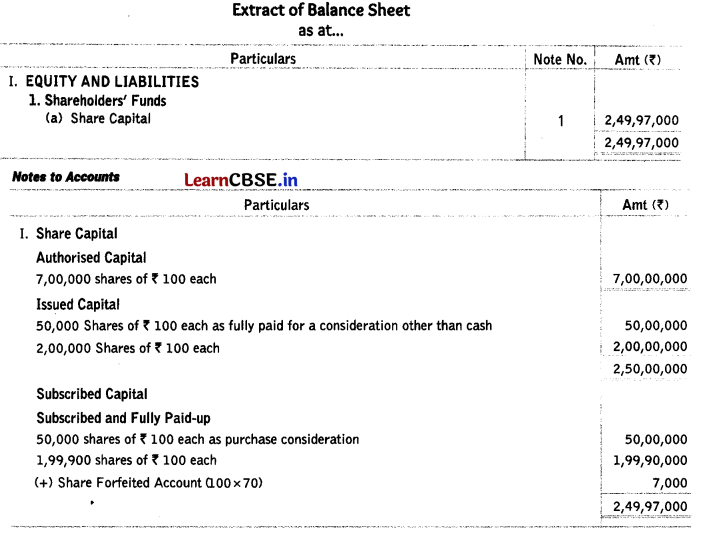
Question 58.
SSS Ltd forfeited 1,000 equity shares of ₹ 100 each for the non-payment of first call ₹ 20 per share and second and final call of ₹ 25 per share. State
(i) Can these shares be re-issued?
(ii) If yes state the minimum amount at which these shares can be re-issued?
(iii) If these shares were re-issued at ₹ 50 per share fully paid up, what will be the amount of capital reserve? (Delhi 2010)
Answer:
(i) Yes, forfeited shares can be re-issued.
(ii) Forfeited shares can re-issued at any rate of discount. The only condition is that the amount of discount allowed on the re-issue of forfeited shares must not exceed the amount forfeited on such shares. In this case, shares can be re-issued at a minimum price of ₹ 45 per share (i.e. 100 – 55).
(iii) Calculation of Amount Transferred to Capital Reserve
Amount forfeited (1,000×55) = 55,000
(-) Discount on re-issue (11)00 x 50) = (50,000)
Gain on re-issue to be transferred to capital reserve = ₹ 5,000
Question 59.
On 1st April, 2012, Vishwas Ltd was formed with an authorised capital of ₹ 10,00,000 divided into 1,00,000 equity shares of ₹ 10 each. The company issued prospectus inviting applications for 90,000 equity shares. The company received applications for 85,000 equity shares. During the first year, ₹ 8 per share were called. Ram holding 1,000 shares and Shyam holding 2,000 shares did not pay the first call of ₹ 2 per share. Shyam’s shares were forfeited after the first call and later on 1,500 of the forfeited shares were re-issued at ₹ 6 per share, ₹ 8 called-up.
Show the following
(i) Share capital in the balance sheet of the company as per Revised Schedule III Part I of the Companies Act, 2013.
(ii) Also prepare ‘notes to accounts’ for the same. (All India 2014)
Answer:
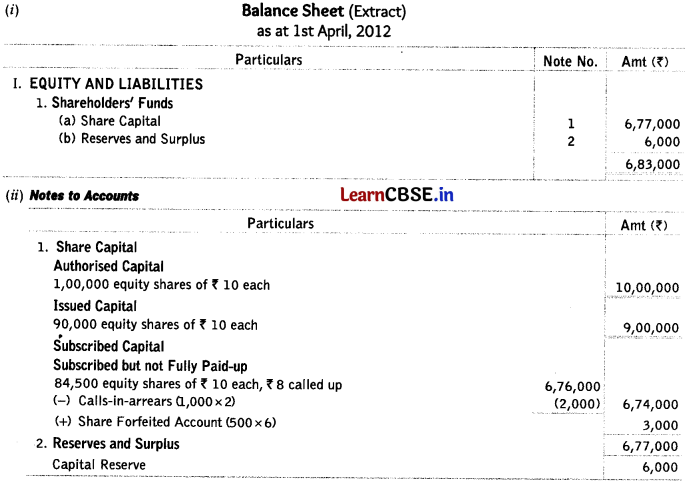
Working Note:
Capital Reserve
(a) Amount forfeited on re-issued shares = 12,000 x \(\frac{1,500}{2,000}\) = ₹ 9,000
(b) Amount utilised at the time of re-issue = ? 3,000 (1,500 x 2)
Capital reserve (a – b) = 9,000 – 3,000 = ₹ 6,000
NOTE Calls-in-arrears will be shown only of Ram’s holding because Shyam’s shares have been forfeited.
Question 60.
B Ltd was registered with an authorised capital of ₹ 20,00,000 divided into equity shares of ₹ 10 each.The company invited applications for the issue of 1,00,000 shares. Applications for 96,000 shares were received. All calls were made and were duly received except the final call of ₹ 2 per share on 2,000 shares. All these shares were forfeited and later on re-issued at ₹ 18,000 as fully paid.
(i) Show how ‘share capital’ will appear in the balance sheet of B Ltd as per Schedule III of the Companies Act, 2013.
(ii) Also prepare ‘Notes to Accounts’ for the same. (All India (C) 2014)
Answer:
Solve as Q no. 10 on page 290 and 291.
Share Capital = ₹ 9,60,000
![]()
Question 61.
L Ltd forfeited 470 equity shares of ₹ 20 each issued at a premium of ₹ 3 per share for the non-payment of allotment money of ₹ 8 (including premium ₹ 3) and first call of ₹ 5 per share. Final call of ₹ 5 per share was not made. Out of these 235 shares were re-issued at ₹ 19 each fully paid. Pass necessary journal entries for the above transactions in the books of L Ltd. (Delhi (C) 2014)
Answer:
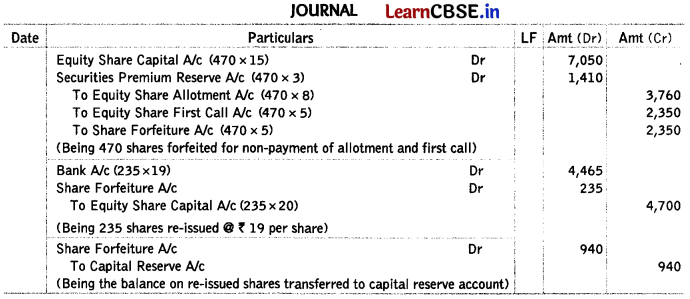
Working Note:
Capital Reserve
Amount forfeited on re-issued shares = 12,000 x 235 = ₹ 1,175
(-) Amount utilised at the time of re-issue = ₹ 235
Capital reserve = ₹ 940
Question 62.
Give journal entries to record the following transaction of forfeiture and re-issue of shares and open share forfeiture account.
L Ltd forfeited 470 equity shares of ₹ 10 each issued at premium of ₹ 5 per share for non-payment of allotment money ₹ 8 per share (including share premium ₹ 5 per share) and the first and final call of ₹ 5 per share. Out of these, 60 equity shares were subsequently re-issued @ ₹ 14 per shares. (Delhi 2011)
Answer:
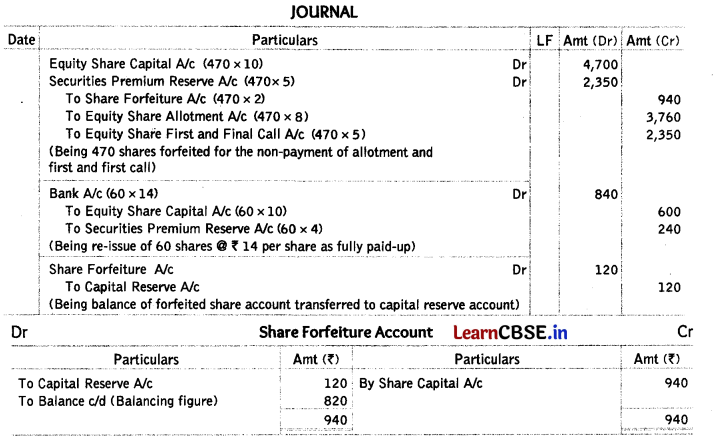
Working Notes:
Amount of 60 forfeited shares = 940 × \(\frac{60}{470}\) = ₹ 120 to be transferred to capital reserve account.
Question 63.
(a) Fill in the blank spaces in the journal entries given below. (All India (C) 2015)
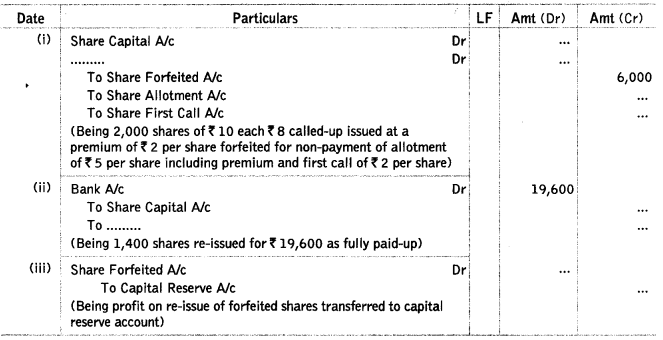
(b) Fill in the blank spaces in the journal entries given below
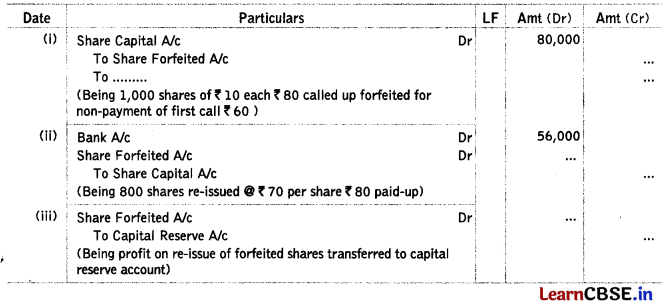
Answer:
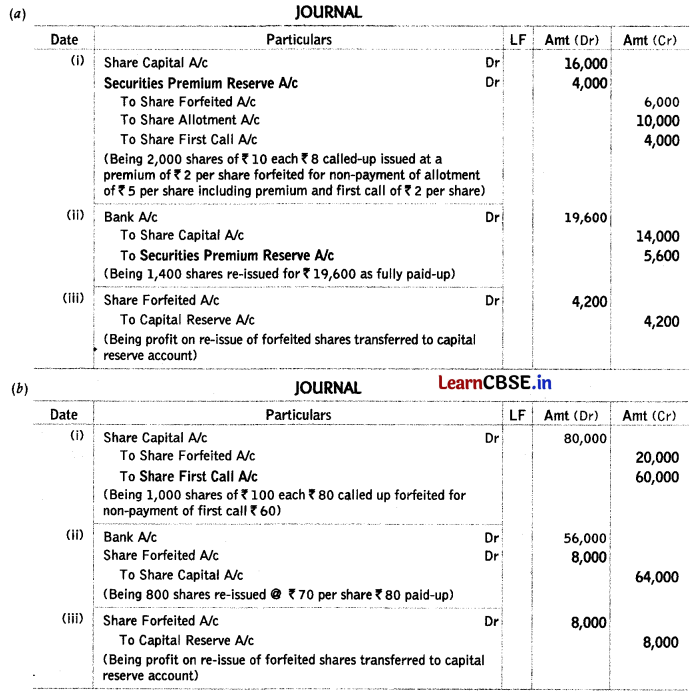
Question 64.
Denspar Ltd invited applications for issuing 2,00,000 equity shares of ₹ 10 each at a premium of ₹ 20 per share. The amount was payable as follows
On application : ₹ 2 per share
On allotment: ₹ 13 per share (including ₹ 10 premium)
On first call: ₹ 7 per share (including ₹ 5 premium)
On final call: ₹ 8 per share (including ₹ 5 premium)
Applications for 1,80,000 shares were received. Shares were allotted to all the applicatns. Yogesh, a shareholder holding 5,000 shares paid his entire share money alongwith the allotment money. Vishesh, a holder of 7,000 shares, failed to pay the allotment money. Afterwards the first call was made. Vishesh paid the allotment money alongwith the first call money. Samyesh, holding 2,000 shares did not pay the final call. Samyesh’s shares were forfeited immediately after the final call. Out of the forfeited shares, 1,500 shares were re-issued at ₹ 8 per share fully paid-up.
Pass the necessary journal entries for the above transactions in the books of Denspar Ltd. (All India 2019)
Answer:
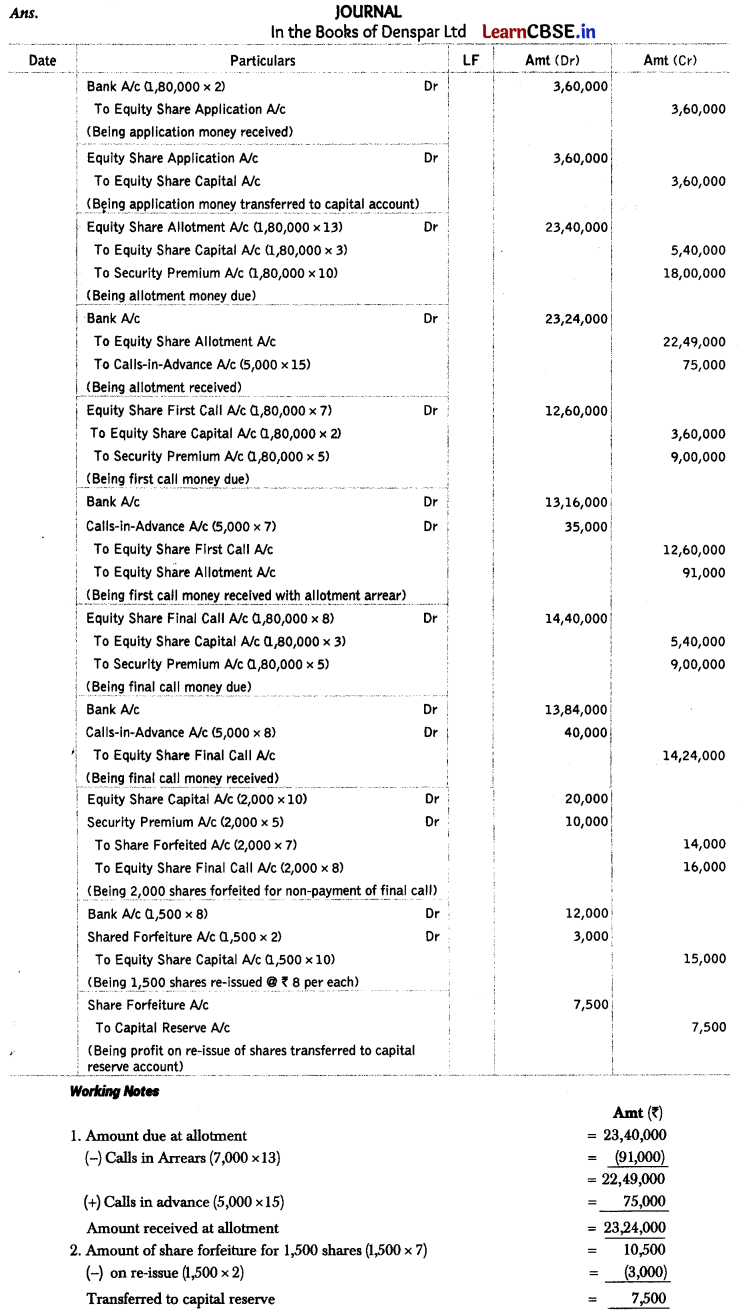
Question 65.
KLN Ltd invited applications for issuing 1,00,000 shares of ₹ 10 each at a premium of ₹ 2 per share. The amount was payable as follows
On Application – ₹ 3 per share (including premium ₹ 1)
On Allotment – ₹ 4 per share (including premium ₹ 1)
On First call – ₹ 3 per share
On Second and Final Call – Balance amount
Application for 1,90,000 shares were received. Allotment was made to the applicants as follows
| Category | No. of Shares Applied | No. of Shares Allotted |
| I | 50,000 | 1,00,000 |
| II | 40,000 | 60,000 |
Remaining applications were rejected.
Rajat, a shareholder belonging to Category I who had applied for 2,500 shares, failed to pay the amount due on allotment and first call. His shares were immediately forfeited.
Reema, a shareholder belonging to Category II who was holding 3,000 shares failed to pay the first call and second call money. Her shares were also forfeited. Afterwards 4,000 shares were re-issued @ ₹ 8 per share fully paid-up. These included all the forfeited shares of Reema.
Pass necessary journal entries for the above transactions in the books of KLN Ltd. (All India 2019)
Answer:
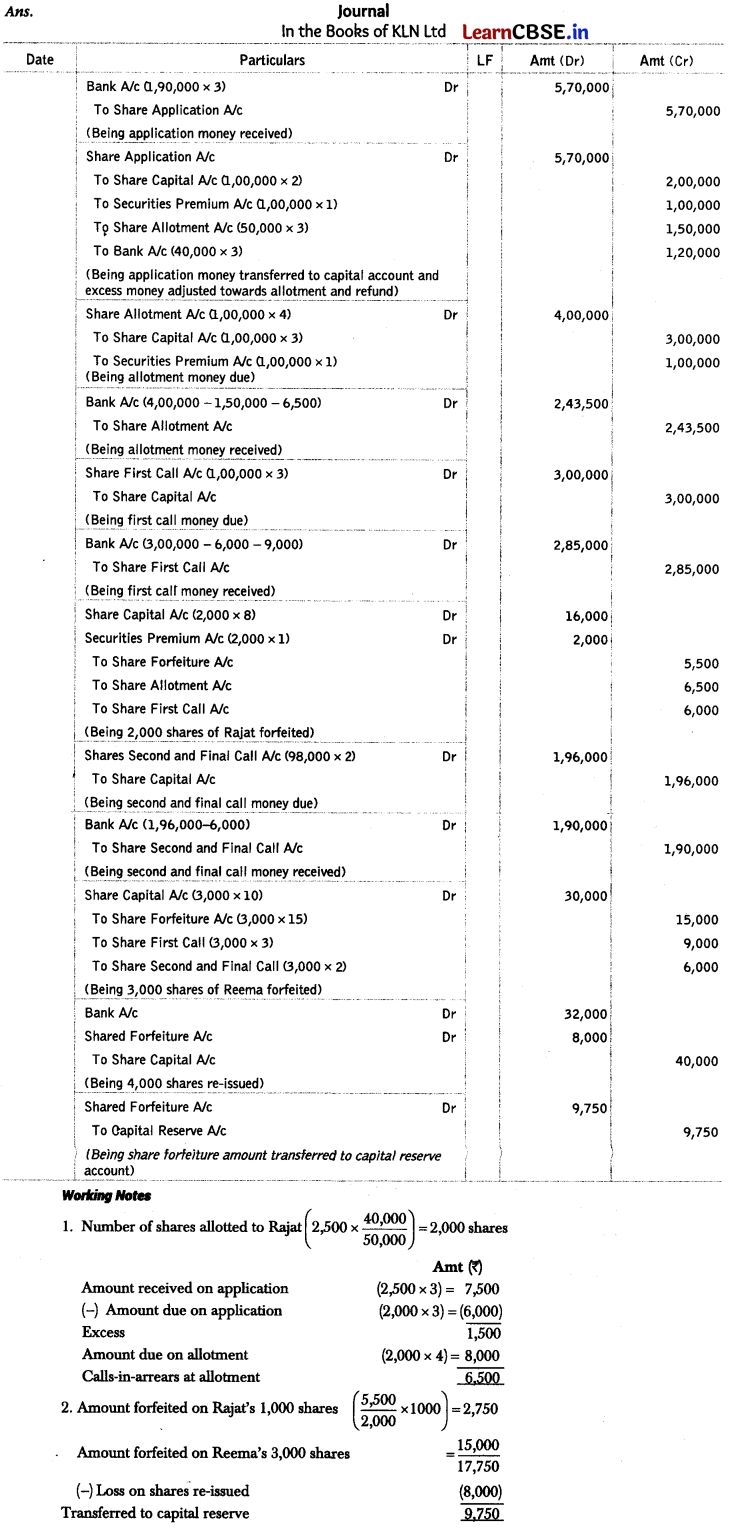
Question 66.
S Ltd invited applications for issuing 1,00,000 equity shares of ₹ 10 each. The shares were issued at a premium of ₹ 5 per share. The amount was payable as follows
On application and allotment – ₹ 8 per share (including premium ₹ 8)
On the first and final call – Balance including premium
Applications for 1,50,000 shares were received. Applications for 10,000 shares were rejected and pro-rata allotment was made to the remaining applicants on the following basis
(i) Applicants for 80,000 shares were allotted 60,000 shares.
(ii) Applicants for 60,000 shares were allotted 40,000 shares.
Excess amount received on application and allotment was to be adjusted against sums due on call. X, who belonged to the first category and was allotted 300 shares, failed to pay the first and final call money. Y, who belonged to the second category and was allotted 200 shares, also failed to pay the first and final call money. Their shares were forfeited. The forfeited shares were re-issued @ ₹ 12 per share as fully paid-up.
Pass necessary cash book and journal entries for the above transactions in the books of the companv. (All India 2019)
Answer:

Question 67.
Jain Ltd invited applications for issuing 1,12,000 equity shares of ₹ 10 each at par. The amount per share was payable as follows
On application – ₹ 1 On allotment – ₹ 2
On first call -13 On second and final call – ₹ 4
Applications for 1,00,000 shares were received, Shares were fully allotted to all the applicants. Ramesh failed to pay his allotment money which was t 2,000. His shares were forfeited immediately. Suresh did not pay the first call on 500 shares applied by him. His shares were forfeited after the first call. The forfeited shares of Ramesh and Suresh were re-issued at ₹ 9 per share fully paid-up. Afterwards the second and final call was made and was duly received.
Pass necessary journal entries for the above transactions in the books of Jain. (All India 2019)
Answer:
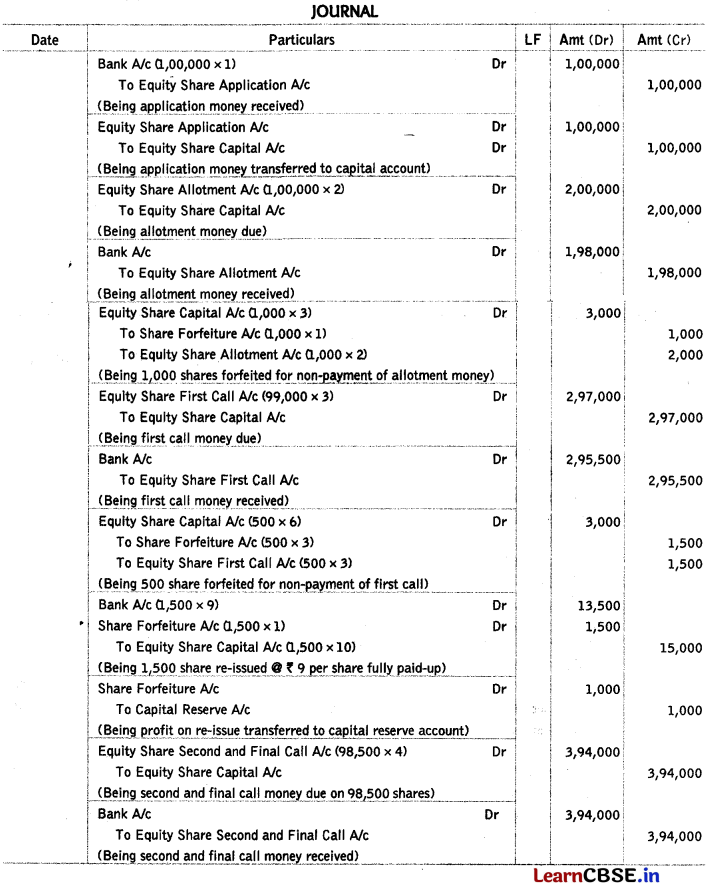
Working otes:
Number of share allotted to Ramesh = \(\frac { 2000 }{ 2 }\) = 1000 shares
![]()
Question 68.
DF Ltd invited applications for issuing 50,000 shares of ₹ 10 each at a premium of ₹ 2 per share. The amount was payable as follows
On application – ₹ 3 per share (including premium ₹ 1)
On allotment – ₹ 3 per share (including premium ₹ 1)
On first call – ₹ 3 per share
On second and final call – Balance amount
Application for 70,000 shares were received. Allotment was made on the following basis
Application for 5,000 shares-full
Applications for 50,000 shares – 90%
Balance of the applications were rejected. ₹ 1,11,000 were received on account of allotment. The amount of allotment due from the shareholders to whom shares were allotted on pro-rata basis was fully received. A few shareholders to whom shares were allotted in full, failed to pay the allotment money ₹ 1,20,000 were received on first call. Directors decided to forfeit those shares on which allotment and call money was due. Half of the forfeited shares were re-issued @ ₹ 8 per share fully paid-up. Final call was not made.
Pass the necessary journal entries for the above transactions in the book of DF Ltd. (Delhi 2019)
Answer:
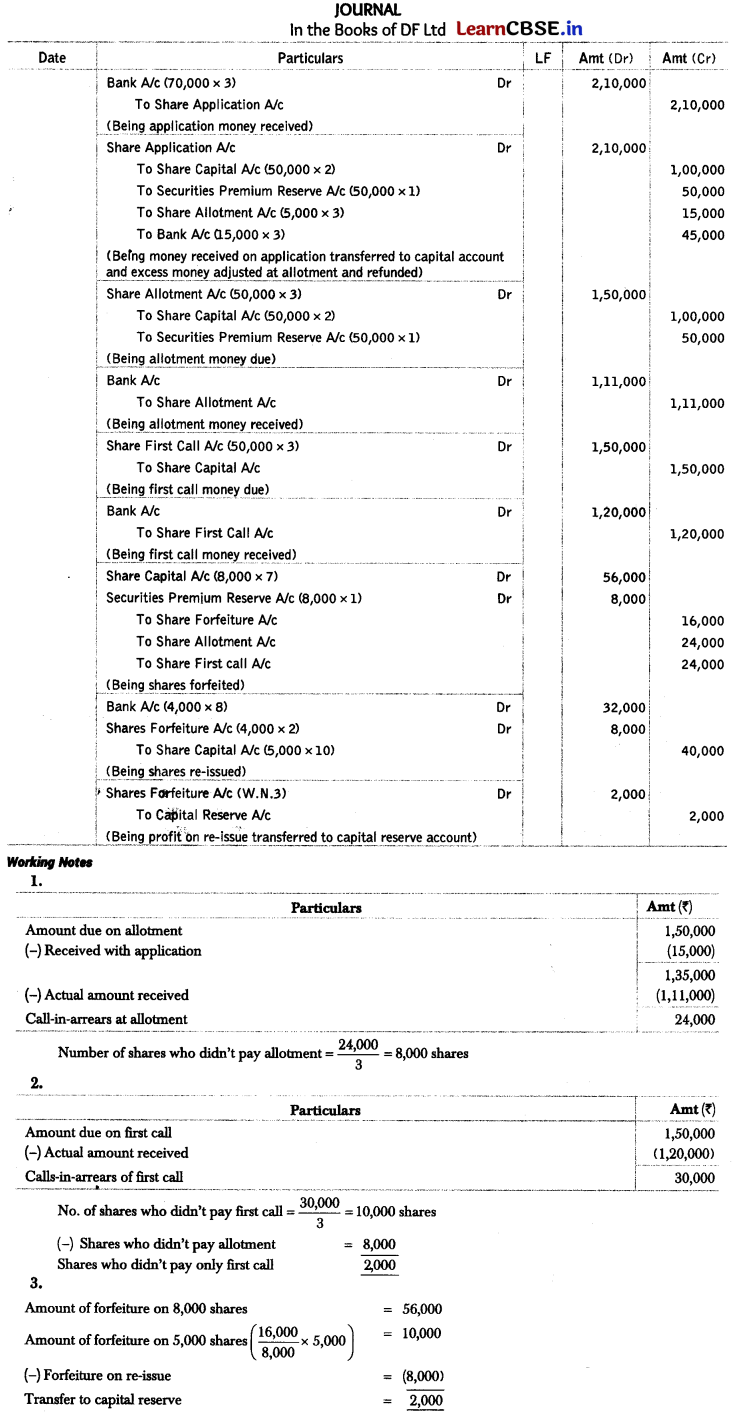
Question 69.
EF Ltd invited applications for issuing 80,000 equity shares of ₹ 50 each at a premium of 20%. The amount was payable as follows
On application – ₹ 20 per share (including premium ₹ 5)
On allotment – ₹ 15 per share (including premium ₹ 5)
On first call – ₹ 15 per share
On second and final call – Balance amount
Applications for 1,20,000 shares were received. Applications for 20,000 shares were rejected and pro-rata allotment was made to the remaining applications.
Seema, holding 4,000 shares failed to pay the allotment money. Afterwards the first call was made. Seema paid allotment money alongwith the first call. Sahaj, who had applied for 2,500 shares failed to pay the first call money. Sahaj’s shares were forfeited and subsequently re-issued to Geeta for ₹ 60 per share, ₹ 50 per share paid-up. Final call was not made.
Pass necessary journal entries for the above transactions in the books of EF Ltd by opening callS-in-arrears account. (Delhi 2019)
Answer:
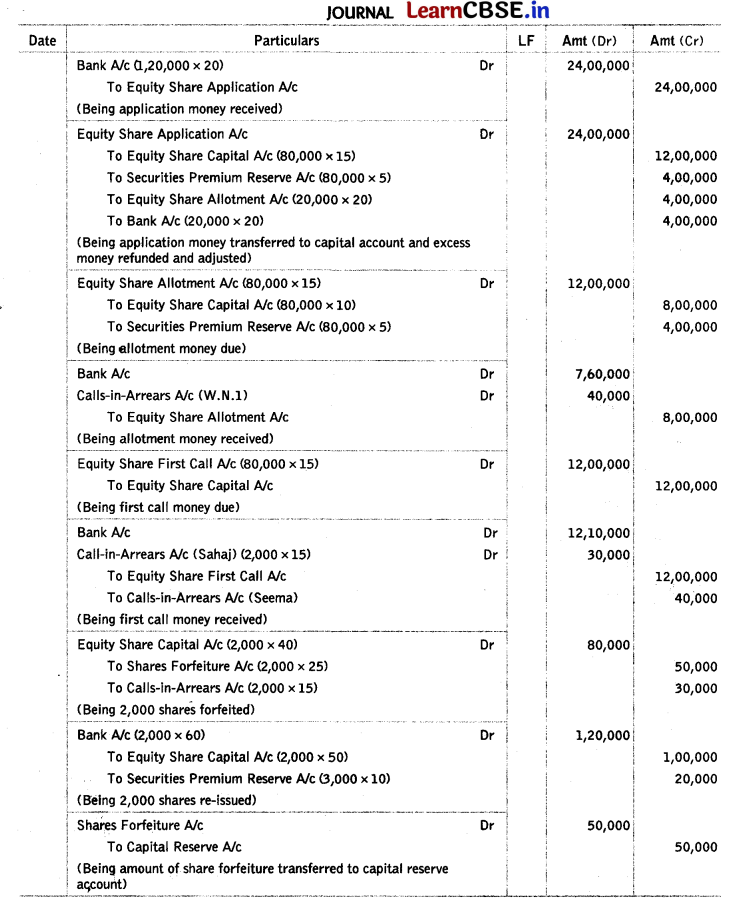
Working Notes:

Question 70.
X Ltd invited applications for issuing 50,000 equity shares of ₹ 10 each. The amount was payable as follows
On Application – ₹ 2 per share
On Allotment – ₹ 2 per shares
On first call – ₹ 3 per shares
On second and final cal – Balance amount
Applications for 70,000 shares were received. Applications for 10,000 shares were rejected and the application money was refunded. Shares were allotted to the remaining applicants on a pro-rata basis and excess money received with applications was transferred towards sums due on allotment and calls, if any.
Gopal, who applied for 600 shares, paid his entire share money with application. Ghosh, who had applied for 6,000 shares, failed to pay the allotment money and his shares were immediately forfeited. These forfeited shares were re-issued to Sultan for ₹ 20,000; ₹ 4 per share paid-up. The first call money and the second and final call money was called and duly received. Pass necessary journal entries for the above transactions in the books of X Ltd. Open calls-in-advance account and calls-in-arrears account wherever necessary. (CBSE 2018)
Answer:
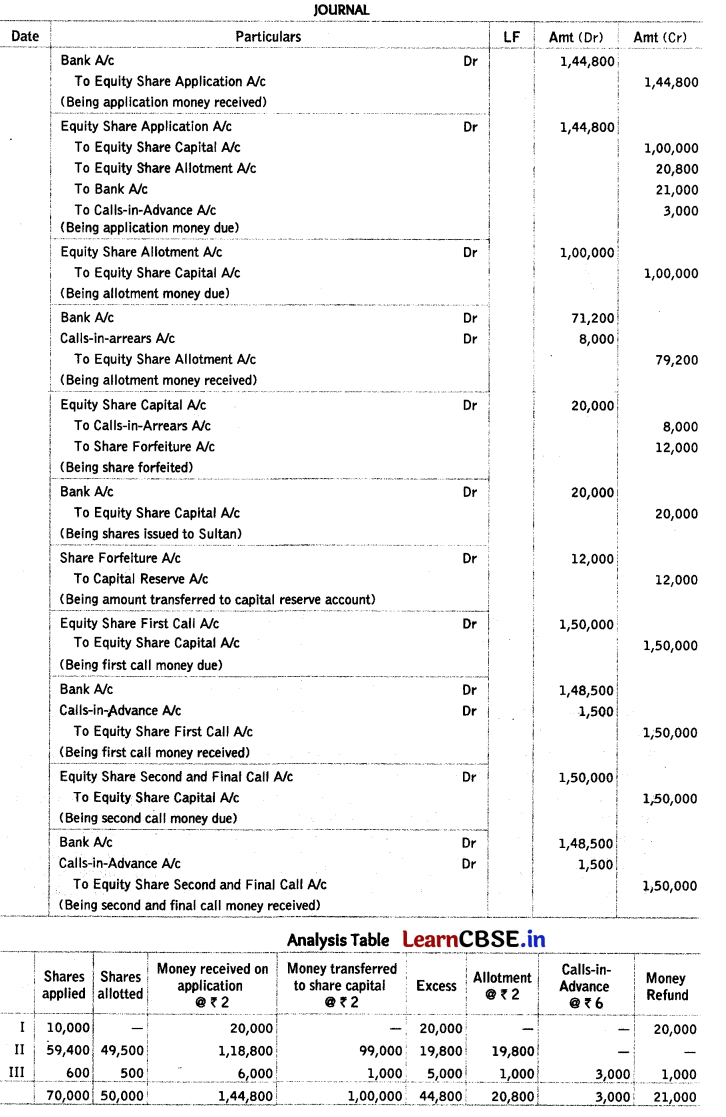
Question 71.
A Ltd invited applications for issuing 1,00,000 shares of ₹ 10 each at a premium of ₹ 1 per share. The amount was payable as follows
On application – ₹ 3 per share
On allotment – ₹ 3 per share (including premium)
On first call – ₹ 3 per share
On second and final call – Balance amount
Applications for 1,60,000 shares were received. Allotment was made on the following basis
(i) To applicants for 90,000 shares – 40,000 shares
(n) To applicants for 50,000 shares – 40,000 shares
(iii) To applicants for 20,000 shares – Full shares
Excess money paid on application is to be adjusted against the amount due on allotment and calls.
Rishabh, a shareholder, who applied for 1,500 shares and belonged to Category (ii), did not pay allotment, first and second and final call money. Another shareholder, Sudha, who applied for 1,800 shares and belonged to Category (i), did not pay the first and second and final call money.
All the shares of Rishabh and Sudha were forfeited and were subsequently re-issued at? 7 per share fully paid.
Pass the necessary journal entries in the books of A Ltd. Open calls-in-arrears account and calls-in-advance account wherever required. (CBSE 2018)
Answer:
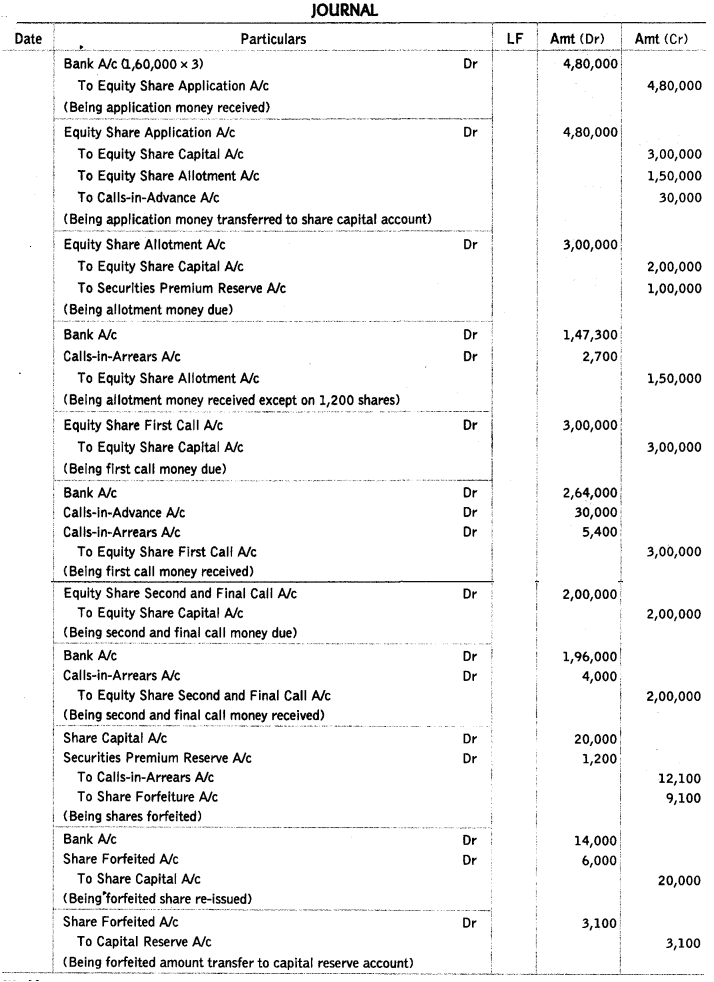
Working Notes:
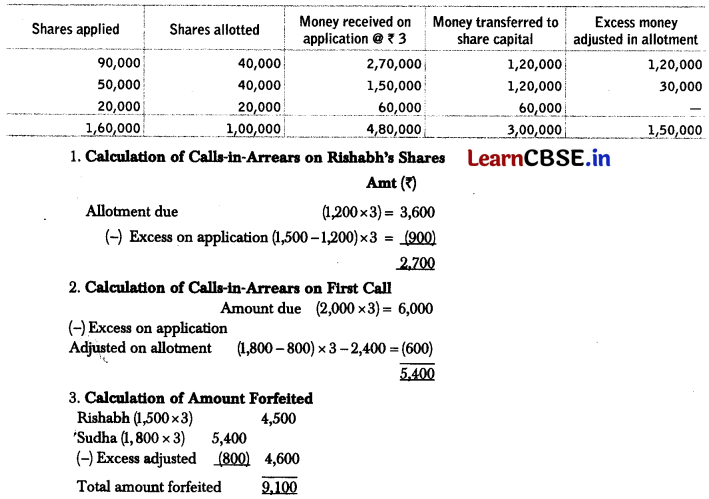
Question 72.
X Ltd invited applications for issuing 5,00,000 equity shares of ₹ 10 each at par. The amount per share was payable as follows
On application – ₹ 1 per share; On allotment – ₹ 2 per share; On first call – ₹ 3 per share; On second and final call – Balance amount
Applications for 8,00,000 shares were received. Applications for 1,00,000 shares were rejected and pro-rata allotment was made to the remaining applicants. Excess money received with applications was adjusted towards sums due on allotment. All calls were made. Ashok, a shareholder, holding 5,000 shares failed to pay the allotment and the call money. Mohan, a shareholder who had applied for 7,000 shares, failed to pay the first and second and final call. Shares of Ashok and Mohan were forfeited after the second and final call. Of the forfeited shares, 8,000 shares were re-issued at ₹ 12 per share fully paid-up. The re-issued shares included all the forfeited shares of Ashok.
Pass necessary journal entries for the above transactions in the books of X. Ltd. (Compartment 2018)
Answer:
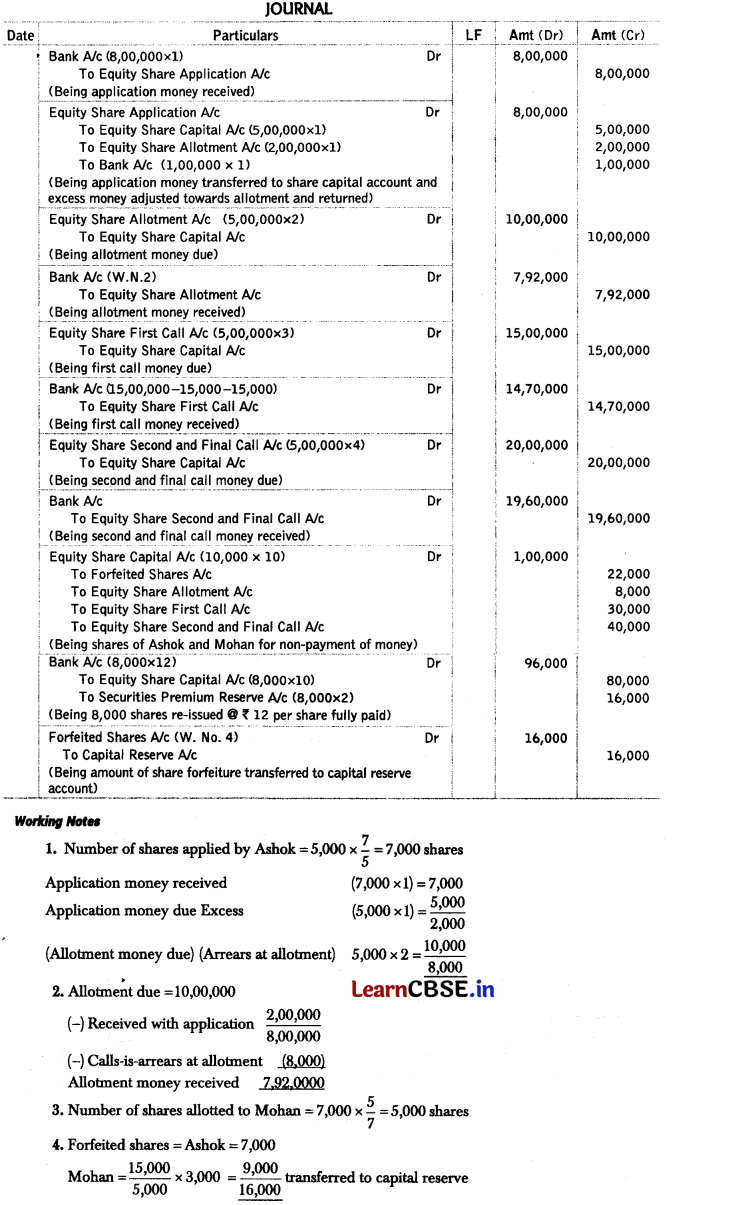
Question 73.
Manvet Ltd invited applications for issuing 10,00,000 equity shares of ₹ 10 each payable as follows
On application and allotment (-) ₹ 4 per share (including premium ₹ 1)
On first call share – ₹ 4 per share
On second and final call – ₹ 3 per share
Applications for 15,00,000 shares were received and pro-rata allotment was made to all the applicants. Excess application money was adjusted on the sums due on calls. A shareholder, who had applied for 6,000 shares did not pay the first, and second and final call. His shares were forfeited. 90% of the forfeited shares were re-issued at ₹ 8 per share fully paid-up.
Pass necessary journal entries for the above transactions in the books of the company. (Comportment 2018)
Answer:
Solve as Q. no. 46 on page 336 and 337.
First Call Money Received = ₹ 19,92,000
Second Call Money Received = ₹ 2938000
Forfeited Shares Amount = ₹ 20000
Capital Reserve = ₹ 10300
![]()
Question 74.
VXN Ltd invited applications for issuing 50,000 equity shares of ₹ 10 each at a premium of ₹ 8 per share. The amount was payable as follows
On application : ₹ 4 per share (including ₹ 2 premium)
On allotment : ₹ 6 per share (including ₹ 3 premium)
On first call : ₹ 5 per share (including ₹ 1 premium)
On second and final call : Balance amount
The issue was fully subscribed. Gopal, a shareholder holding 200 shares, did not pay the allotment money and Madhav, a holder of 400 shares, paid his entire share money along with the allotment money. Gopal’s shares were immediately forfeited after allotment. Afterwards, the first call was made. Krishna, a holder of 100 shares, failed to pay the first call money and Girdhar, a holder of 300 shares, paid the second call money also along with the first call. Krishna’s shares were forfeited immediately after the first call. Second and final call was made afterwards and was duly received. All the forfeited shares were re-issued at ₹ 9 per share fully paid-up.
Pass necessary journal entries for the above transactions in the books of the company. (All India 2017)
Answer:
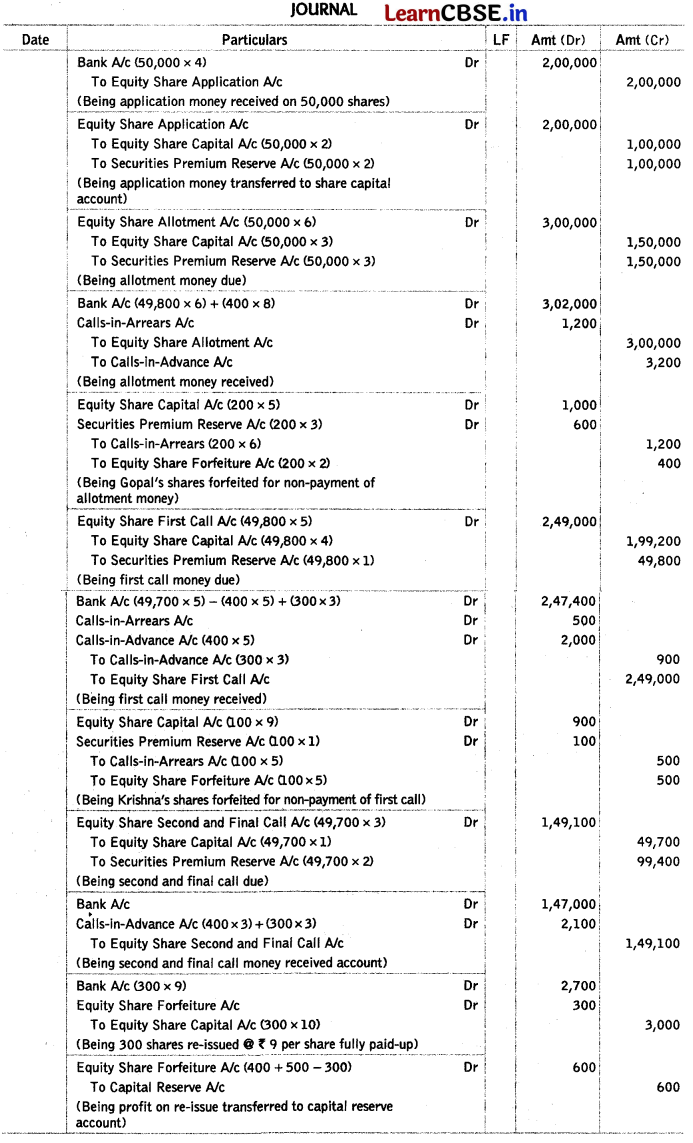
Question 75.
JJK Ltd invited applications for issuing 50,000 equity shares of ₹ 10 each at par. The amount was payable as follows
On application – ₹ 2 per share
On allotment – ₹ 4 per share
On first and final call – Balance amount
The issue was over-subscribed three times. Applications for 30% shares were rejected and money refunded. Allotment was made to the remaining applicants as follows
| Category | No. of Shares Applied | No. of Shares Allotted |
| I | 80,000 | 40,000 |
| II | 25,000 | 10,000 |
Excess money paid by the applicants who were allotted shares was adjusted towards the sums due on allotment.
Deepak, a shareholder belonging to Category I, who had applied for 1,000 shares, failed to pay the allotment money. Raju, a shareholder holding 100 shares, also failed to pay the allotment money. Raju belonged to Category II. Shares of both Deepak and Raju were forfeited immediately after allotment. Afterwards, first and final call was made and was duly received. The forfeited shares of Deepak and Raju were re-issued at ₹ 11 per share fully paid up.
Pass necessary journal entries for the above transactions in the books of the company. (All India 2017)
Answer:
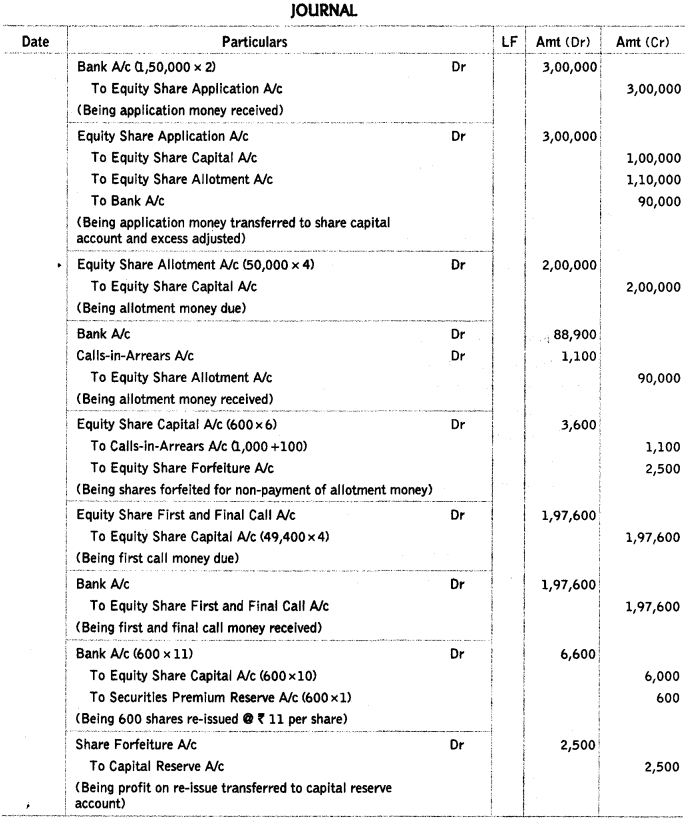
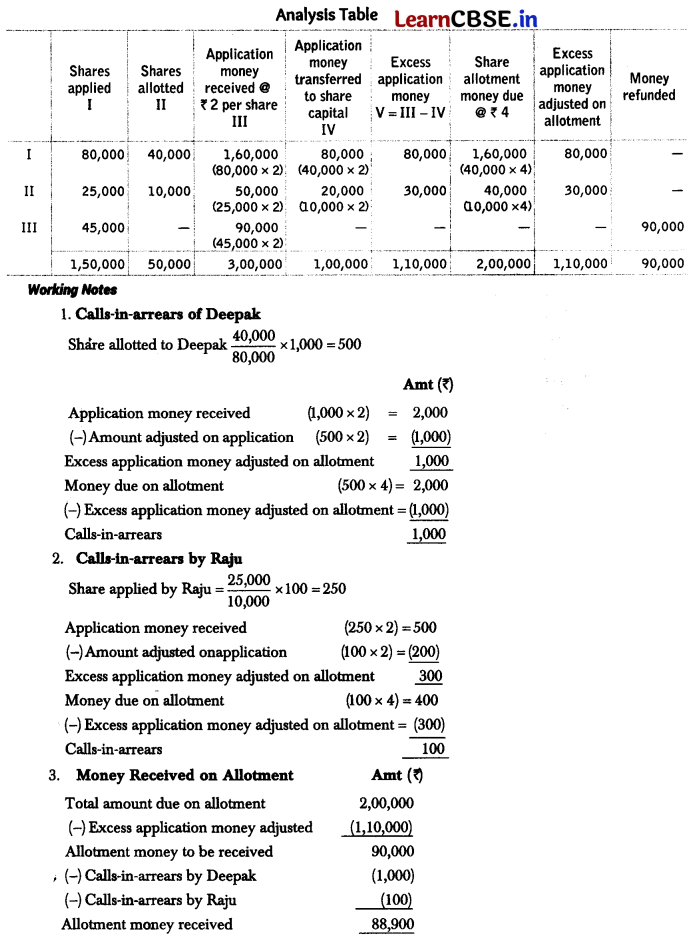
Question 76.
XL Ltd invited applications for issuing 1,00,000 equity shares of ₹ 10 each at par. The amount was payable as follows
On application – ₹ 3 per share
On allotment – ₹ 4 per share
On first and final call – ₹ 3 per share
The issue was over-subscribed by three times. Applications for 20% shares were rejected and the money refunded. Allotment was made to the remaining applications as follows
| Category | No. of Shares Applied | No. of Shares Allotted |
| I | 1,60,000 | 80,000 |
| II | 80,000 | 20,000 |
Excess money received with applications was adjusted towards sums due on allotment and first and final call. All calls were made and were duly received except the final call by a shareholder belonging to Category I who has applied for 320 shares. His shares were forfeited. The forfeited shares were re-issued at ₹ 15 per share fully paid-up.
Pass necessary journal entries for the above transactions in the book of XL Ltd. Open calls in-arrears and calls-in-advance account whenever required. (Delhi 2017)
Answer:
Solve as Q. no. 29 on page 314-316.
Capital Reserve = ₹ 1,120
Question 77.
AXN Ltd invited applications for issuing 1,00,000 equity shares of ₹ 10 each at a premium of ₹ 6 per share. The amount was payable as follows On application ₹ 4 per share (including 2 premium)
On allotment – ₹ 5 per share (including ₹ 2 premium).
On first call – ₹ 4 per share (including ₹ 2 premium).
On second and final cal – Balance amount
The issue was fully subscribed.
Kumar, the holder of 400 shares did not pay the allotment money and Ravi, the holder of 1,000 shares paid his entire share money along with allotment money.
Kumar’s shares were forfeited immediately after allotment. Afterwards first call was made. Gupta, a holder of 300 shares failed to pay the first call money and Gopal, a holder of 600 shares paid the second call money also along with first call. Gupta’s shares were forfeited immediately after the first call. Second and final call was made afterwards. The whole amount due on second call was received.
All the forfeited shares were re-issued at ₹ 9 per share fully paid-up.
Pass necessary journal entries for the above transactions in the books of the company. (Delhi 2017)
Answer:
Solve as Q. No. 28 on page 313 and 314.
Capital Reserve = ₹ 1,600
Question 78.
SK Ltd invited applications for issuing 3,20,000 equity shares of ₹ 10 each at a premium of ₹ 5 per share. The amount was payable as follows
On application – ₹ 3 per share (including premium ₹ 1 per share)
On allotment – ₹ 5 per share (including premium ₹ 2 per share)
On first and final call – Balance amount
Applications for 4,00,000 shares were received. Applications for 40,000 shares were rejected and application money refunded. Shares were alloted on pro-rata basis to the remaining applicants. Excess money received with applications was adjusted towards sums due on allotment. Jeevan holding 800 shares failed to pay the allotment money and his shares were immediately forfeited.
Afterwards final call was made, Ganesh, who had applied for 2,700 shares failed to pay the final call. His shares were also forfeited. Out of the forfeited shares 1,500 shares were re-issued at ₹ 8 per share fully paid up. The re-issued shares included all the forfeited shares of Jeevan.
Pass necessary journal entries for the above transactions in the books of the company. (All India 2016)
Answer:
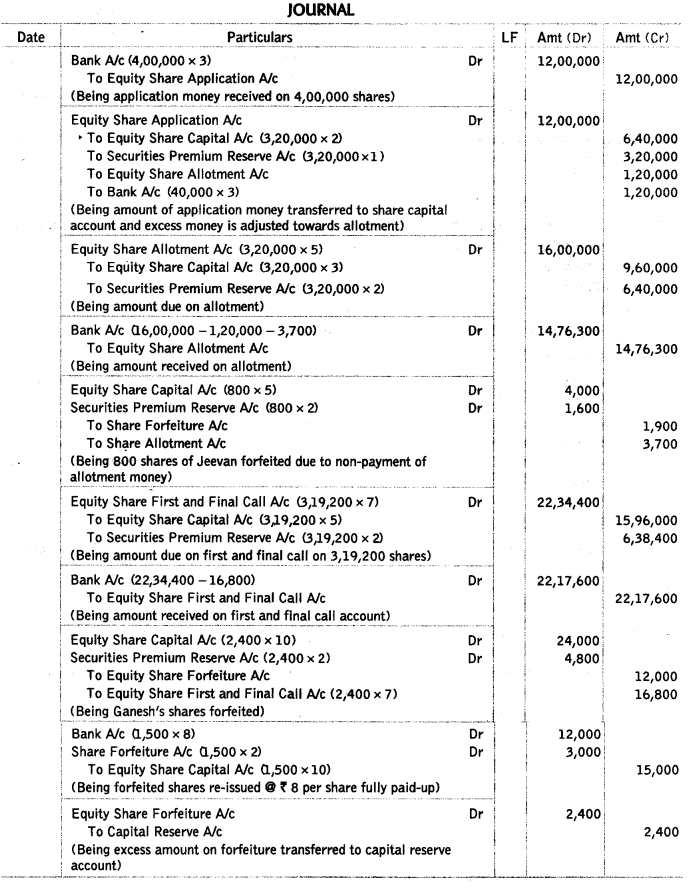
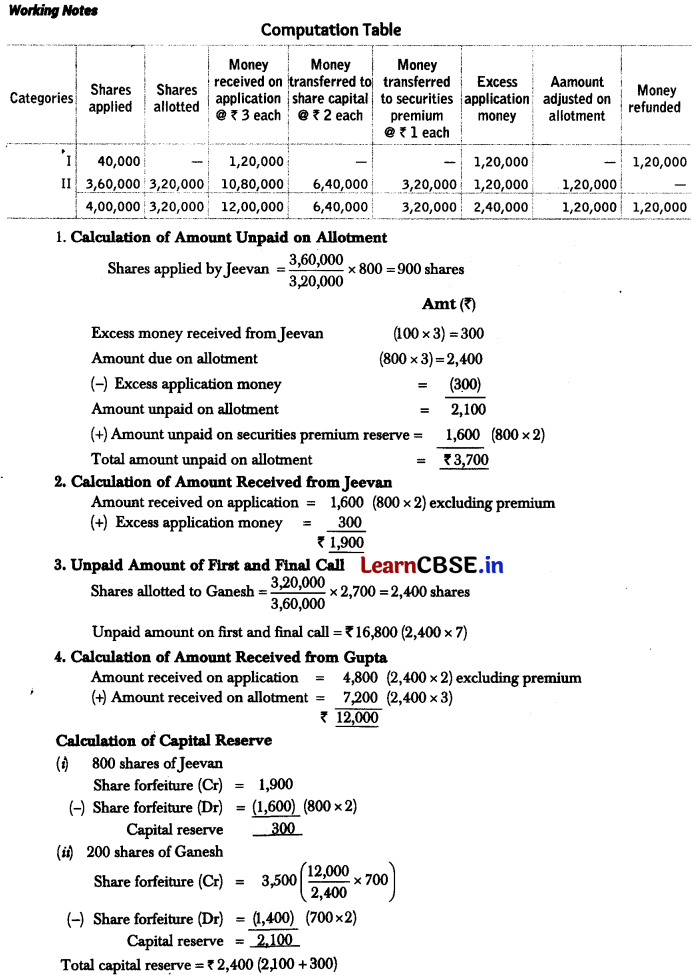
Question 79.
BBG Ltd had issued 1,00,000 equity shares of ₹ 10 each at a premium of ₹ 3 per share payable with application money. While passing journal entries related to the issue, some blanks are left, you are required to complete these blanks. All India 2016

Answer:
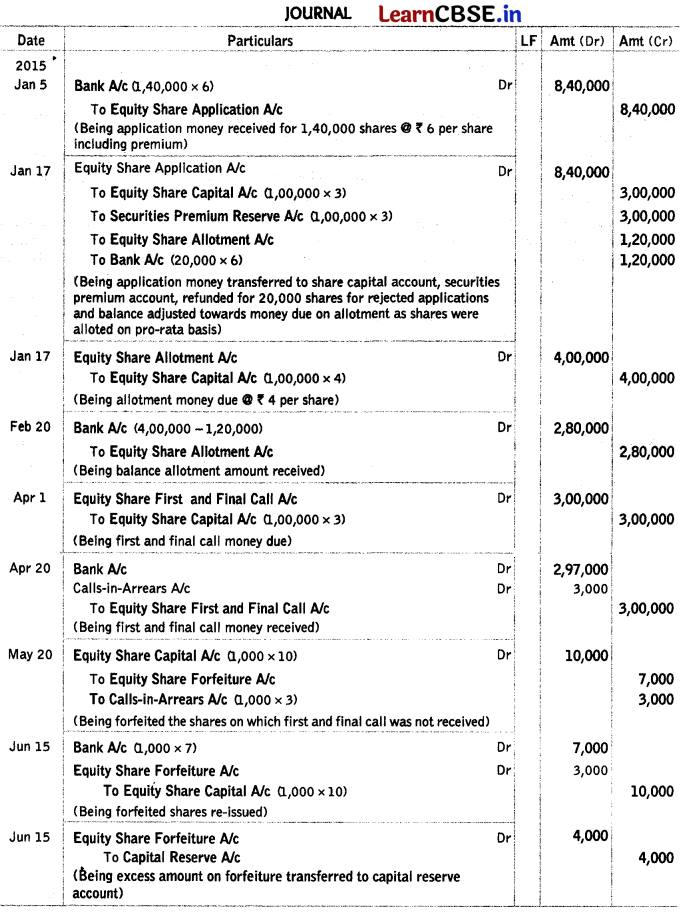
Question 80.
KS Ltd invited applications for issuing 1,60,000 equity shares of ₹ 10 each at a premium of ₹ 6 per share. The amount was payable as follows
On application – ₹ 4 per share (including premium ₹ 1 per share)
On allotment – ₹ 6 per share (including premium ₹ 3 per share)
On first and final call – Balance amount
Applications for 3,20,000 shares were received. Applications for 80,000 shares were rejected and application money refunded. Shares were allotted on pro-rata basis to the remaining applicants. Excess money received with applications was adjusted towards sum due on allotment. Jain holding 800 shares failed to pay the allotment money. His shares were forfeited immediately after allotment. Afterwards the final call was made. Gupta who had applied for 1,200 shares failed to pay the final call. These shares were also forfeited. Out of the forfeited shares 1,000 shares were re-issued at ₹ 8 per share fully paid-up. The re-issued shares included all the forfeited shares of Jain.
Pass necessary journal entries for the above transactions in the books of KS Ltd. (Delhi 2016)
Answer:
Solve as Q no. 32 on page 317-320.
Capital Reserve = ₹ 3,200
Question 81.
GG Ltd had issued 50,000 equity shares of ₹ 10 each at a premium of ₹ 2 per share payable with application money. The incomplete journal entries related to the issue are given below. You are required to complete these blanks.
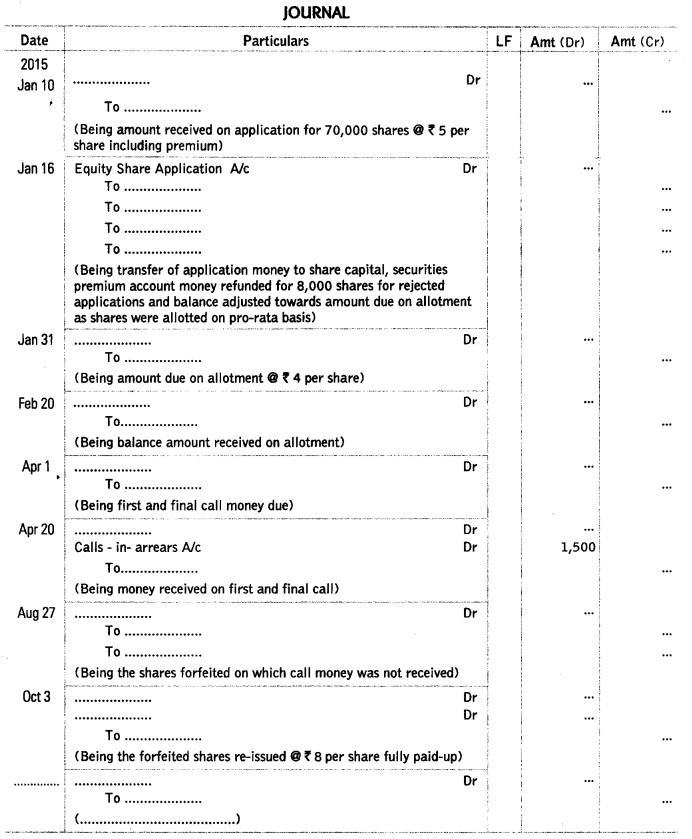
Answer:
Solve as Q no. 33 on page 320-322.
Capital Reserve = ₹ 2,500
Question 82.
Radha Mohan Ltd invited applications for issuing 4,00,000 equity shares of ₹ 50 each. The amount was payable as follows
On application – ₹ 15 per share
On allotment – ₹ 25 per share
On first and final call – ₹ 10 per share
Applications for 6,00,000 shares were received and pro-rata allotment was applicants on following basis
Applicants for 4,00,000 shares were allotted 3,00,000 shares.
Applicants for 2,00,000 shares were alloted 1,00,000 shares.
It was decided that excess amount received on applications will be adjusted towards sums due on allotment and surplus if any, will be refunded. Vibhuti, who was alloted 6,000 shares out of the group applying for 4,00,000 shares did not pay the allotment money and his shares were forfeited immediately. Afterwards, these forfeited shares were re-issued at ₹ 30 per share fully paid-up. Later on, first and final call was made. Shahid, who had applied for 2,000 shares out of the group applying for 2,00,000 shares failed to pay first and final call and his shares were also forfeited. These shares were afterwards re-issued at ₹ 60 per share fully paid-up.
Pass necessary journal entries in the books of Radha Mohan Ltd for the above transactions. (All India (C) 2016)
Answer:
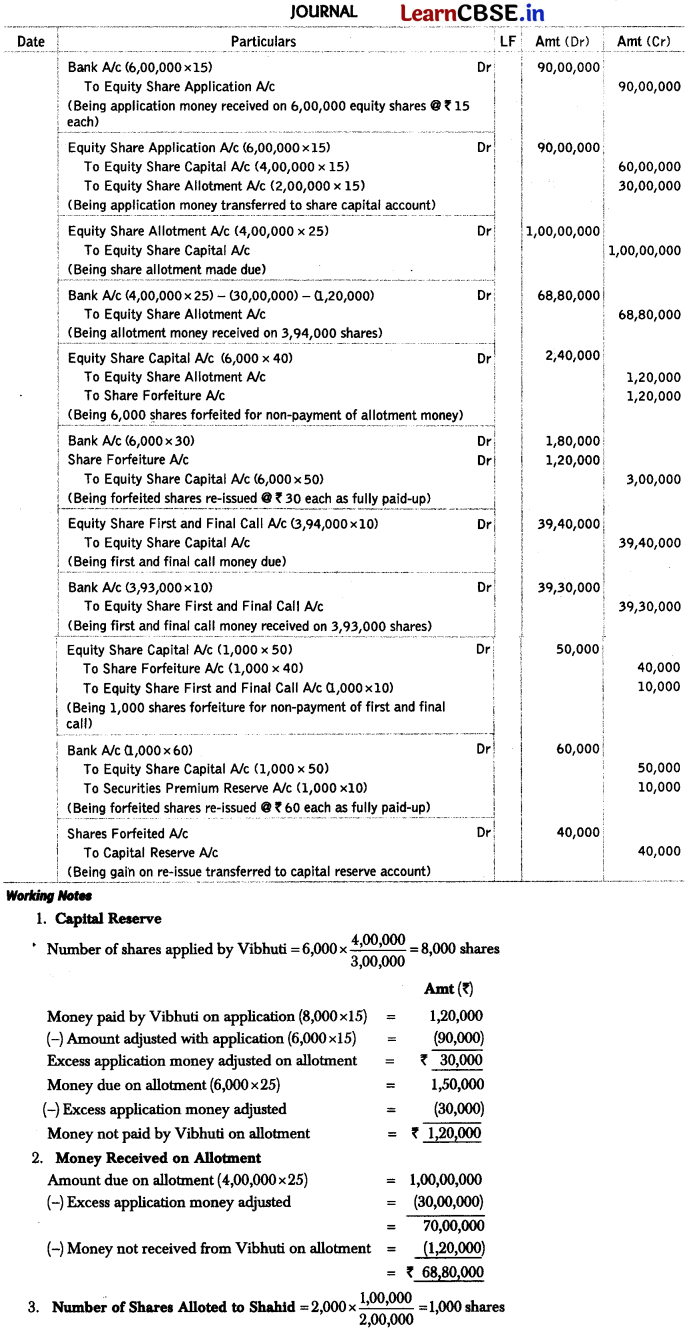
![]()
Question 83.
Sukanya Ltd invited applications for issuing 1,00,000 equity shares of 7 10 each. The shares were issued at a premium of? 20 per share. The amount was payable as follows
On application and allotment – ₹ 14 per share (including premium of? 10)
On first call – ₹ 8 per share (including premium of ₹ 5)
On final call – ₹ 8 per share (including premium of ₹ 5)
Applications for 96,000 shares were received. Rohit a shareholder holding 7,000 shares failed to pay both the calls and Namit, a holder of 5,000 shares did not pay the final call. Shares of Rohit and Namit were forfeited. Of the forfeited shares 8,000 shares including all the shares of Rohit were re-issued to Reena at ₹ 8 per share fully paid-up. Pass necessary journal entries for the above transactions in the books of Sukanya Ltd. (All India (C) 2016)
Answer:
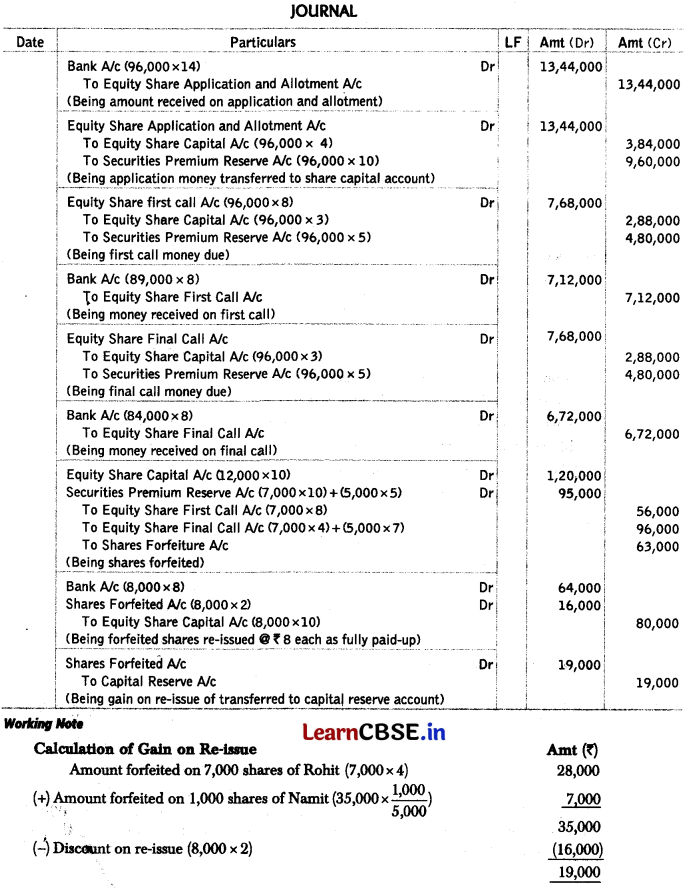
Question 84.
RK Ltd invited applications for issuing 80,000 equity shares of ₹ 10 each at a premium of ₹ 35 per share. The amount was payable as follows
On application – ₹ 8 (including ₹ 5 premium) per share
On allotment – ₹ 12 (including ₹ 10 premium) per share
On first and final call – Balance amount
Applications for 75,000 shares were received and allotment was made to all the applicants. Rahim, a shareholder, who was allotted 3,000 shares failed to pay allotment money and his shares were immediately forfeited.
Afterwards, the first and final call was made. Suhani who held 3,000 shares failed to pay the final call. Her shares were also forfeited. All the forfeited shares were re-issued for a sum of ₹ 62,000 as fully paid-up. Pass necessary journal entries for the above transactions in the books of RK Ltd. (Delhi (C) 2016)
Answer:
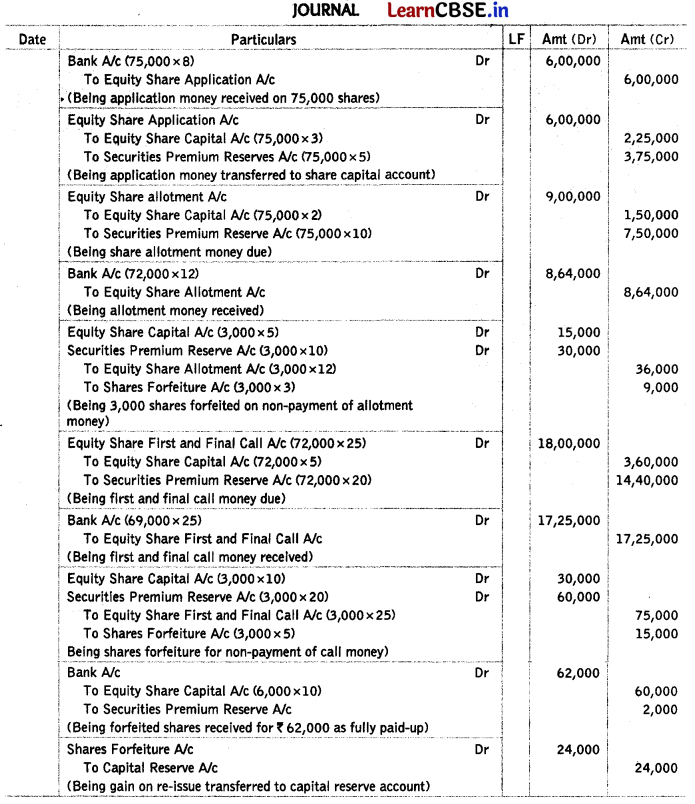
Question 85.
Sargam Ltd invited applications for issuing 80,000 equity shares of ₹ 100 each at a premium. The amount was payable as follows
On application – ₹ 20 per share
On allotment – ₹ 60 (including premium) per share
On first and final call – ₹ 40 per share
Applications for 1,20,000 shares were received. Allotment was made on pro-rata basis to all the applicants. Excess money received on applications was adjusted on sums due to allotment. Sitaram, who had applied for 6,000 shares failed to pay the allotment money and Harnam did not pay first and final call on 800 shares allotted to him. The shares of Sitaram and Harnam were forfeited. 4,200 of these shares were re-issued for ₹ 100 per share as fully paid-up. The re-issued shares included all the forfeited shares of HarnAnswer:
Pass necessary journal entries for the above transactions in the books of Sargam Ltd. (Delhi (C) 2016)
Answer:
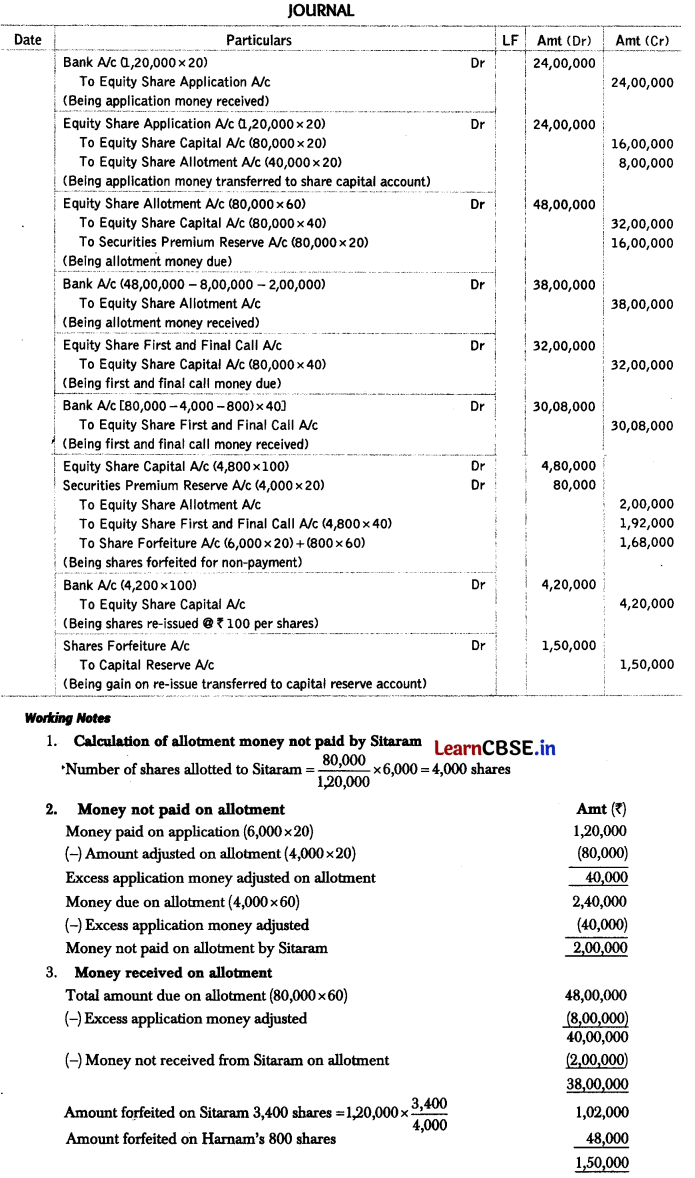
Question 86.
‘BMY Ltd’ invited applications for issuing 1,00,000 equity shares of ₹ 10 each at a premium of ₹ 10 per share. The amount was payable as follows
On application – ₹ 10 per share (including ₹ 5 premium)
On allotment – The balance
The issue was fully subscribed. A shareholder holding 300 shares paid the full share money with application. Another shareholder holding 200 shares failed to pay the allotment money. His ‘shares were forfeited. Later on, these shares were re-issued for ₹ 4,000 as fully paid-up. Pass necessary journal entries for the above transactions in the books of BMY Ltd. (All India 2015)
Answer:
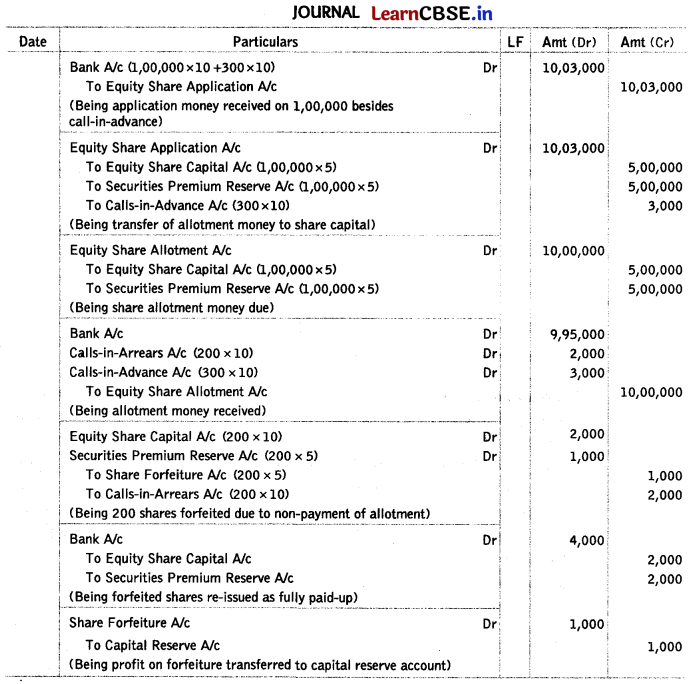
Question 87.
‘Blue Star Ltd’ was registered with an authorised capital of ₹ 2,00,000 divided into 20,000 shares of ₹ 10 each. 6,000 of these shares were issued to the vendor for building purchased. 8,000 shares were issued to the public and ₹ 5 per share were called-up as follows
On application – ₹ 2 per share
On allotment – ₹ 1 per share
On first call – Balance of the calledup amount
The amounts received on these shares were as follows
On 6,000 shares – Full amount called
On 1,25G shares – ₹ 3 per share
On 750 shares – ₹ 2 per share
The directors forfeited 750 shares on which ₹ 2 per share were received. Pass necessary journal entries forth e above transactions in the book of Blue Star Ltd. (All India 2018)
Answer:
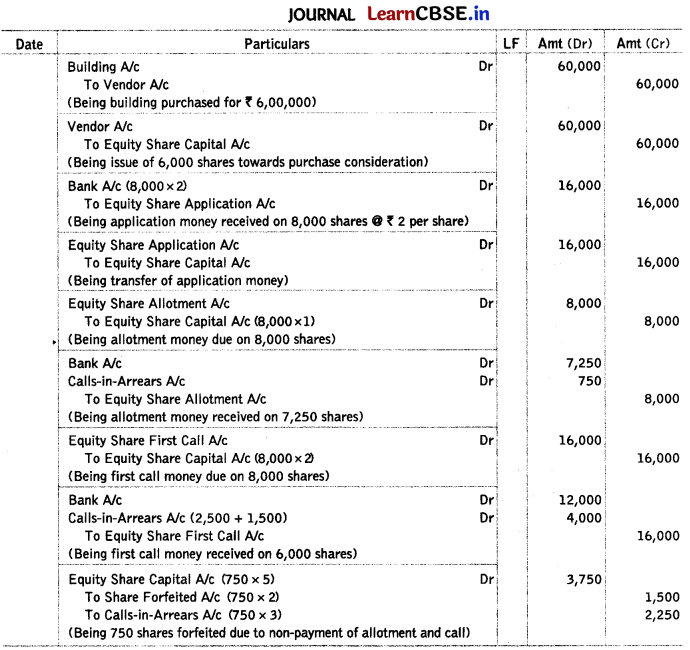
Question 88.
“Y Ltd’ invited applications for issuing 15,000 equity shares of ₹ 10 each on which ₹ 6 per share were called-up, which were payable as follows
On application – ₹ 2 per share
On allotment – ₹ 1 per share
On first call – ₹ 3 per share
The issue was fully subscribed and the amount was received as follows
On 10,000 shares – ₹ 6 per share
On 3,000 shares – ₹ 3 per share
On 2,000 shares – ₹ 2 per share
The directors forfeited those shares on which less than ₹ 6 per share were received. The forfeited shares were re-issued at ₹ 9 per share, as ₹ 6 per share paid-up.
Pass necessary journal entries for the above transactions in the books of the company. (All India 2015)
Answer:
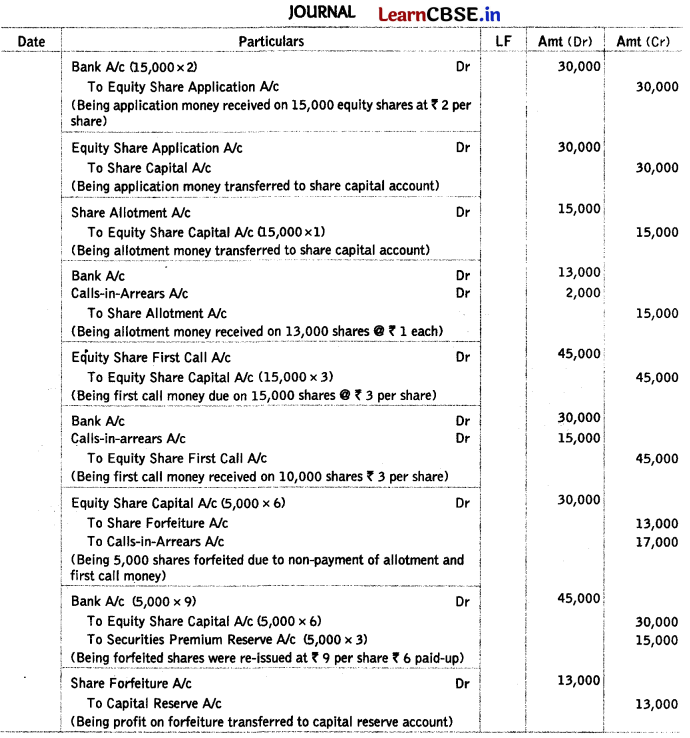
Question 89.
Alfa Ltd invited applications for issuing 75,000 equity shares of ₹ 10 each. The amount was payable as follows
On application and allotment – ₹ 4 per share
On first call – ₹ 3 per share
On second and final call – Balance amount
Applications for 1,00,000 shares were received. Shares were allotted to all the applicants on pro-rata basis and excess money received with applications was transferred towards sums due on first call. Vibha who was allotted 750 shares failed to pay the first call. Her shares were immediately forfeited. Afterwards the second call was made.
The amount due on second call was also received except on 1,000 shares, applied by Monika. Her shares were also forfeited. All the forfeited shares were re-issued to Mohit for ₹ 9,000 as fully paid-up.
Pass necessary journal entries in the books of Alfa Ltd for the above transactions. (Delhi 2015)
Answer:
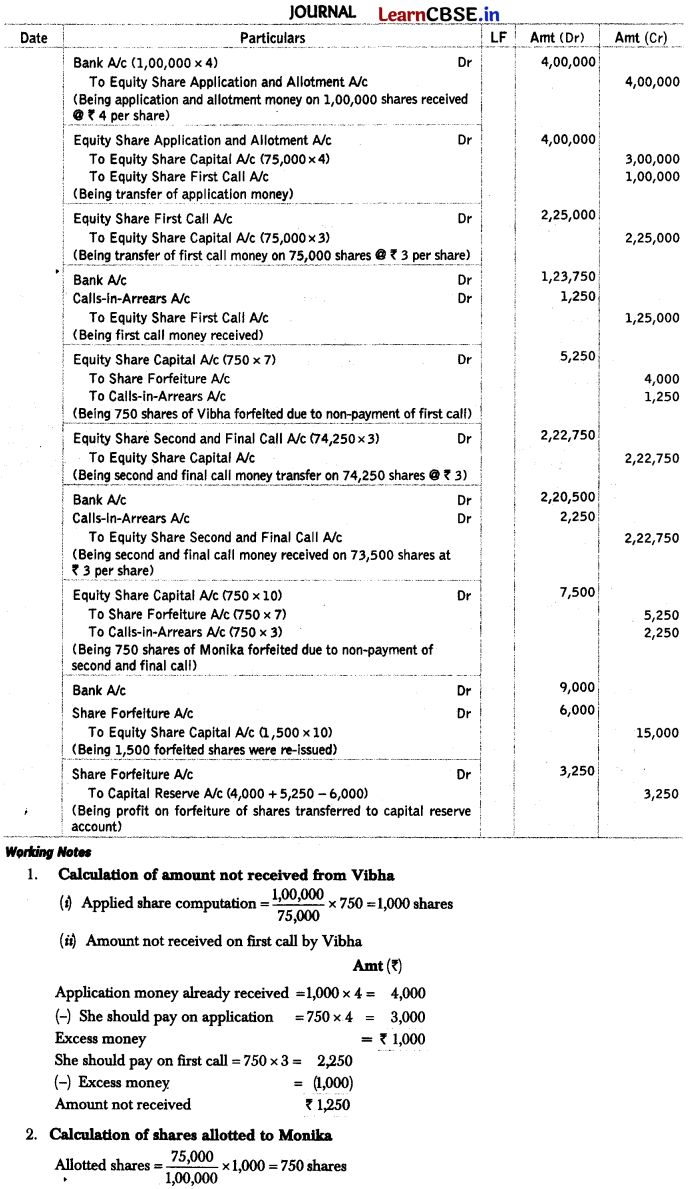
Question 90.
Jeevan Dhara Ltd invited applications for issuing 1,20,000 equity shares of? 10 each at a premium of ₹ 2 per share. The amount was payable as follows
On application – ₹ 2 per share
On allotment – ₹ 5 per share (including premium)
On first and final call – Balance amount
Applications for 1,50,000 shares were received. Shares were allotted to all the applicants on pro-rata basis. Excess money received on applications was adjusted towards sums due on allotment. All calls were made. Manu who had applied for 3,000 shares failed to pay the amount due on allotment and first and final call. Madhur who was allotted 2,400 shares failed to pay the first and final call. Shares of both Manu and Madhur were forfeited. The forfeited shares were re-issued at ₹ 9 per share as fully paid-up.
Pass necessary journal entries for the above transactions in the books of Jeevan Dhara Ltd. (Delhi 2015)
Answer:
Solve as Q no. 39 on page 328 and 329.
Capital Reserve = ₹ 13,200
Question 91.
‘Guru Ltd’ invited applications for issuing 80,000 equity shares of ₹ 10 each at a premium of ₹ 10 per share. The amount was payable as follows
On application and allotment – ₹ 10 (including ₹ 5 premium)
On first and final call – ₹ 10 (including ₹ 5 premium)
Applications for 1,00,000 share were received. Applications for 10,000 shares were rejected and application money was refunded. Shares were allotted on pro-rata basis to the remaining applicants.
Excess application money received from applicants to whom shares were allotted on pro-rata basis was adjusted towards sums due on first and final call. All calls were made and were duly received except the first and final call money from Kumar who had applied for 1,800 shares. His shares were forfeited. The forfeited shares were re-issued at ₹ 9 per share as fully paid-up.
Pass necessary journal entries for the above transactions in the books of ‘Guru Ltd’. (Foreign 2015)
Answer:
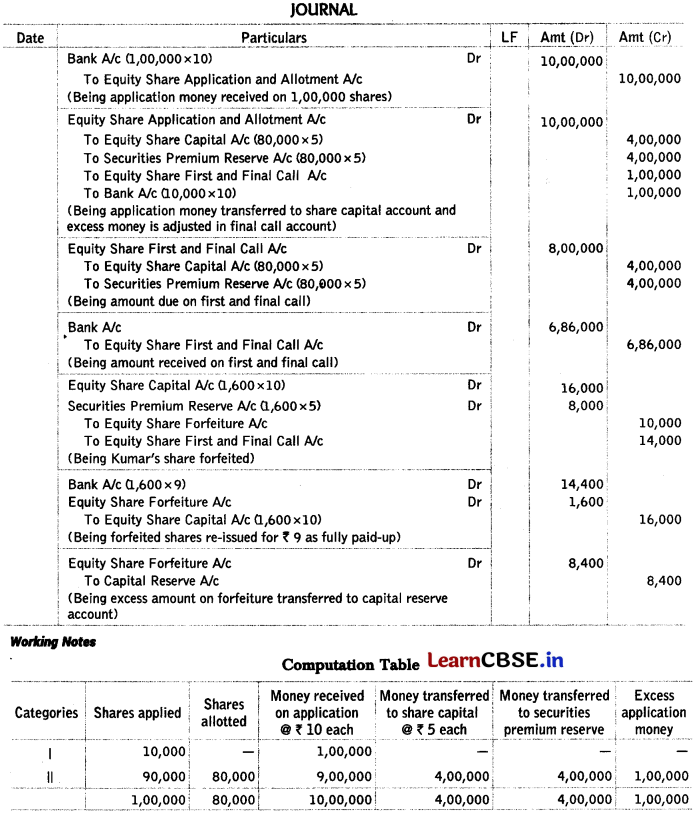
1. Calculation of Amount not Received on First and Final Call
Shares allotted to Kumar = \(\frac { 80,000 }{ 90,000 }\) x 1,800 = 1,600 shares 90,000
Amount received on 1,800 shares @ ₹ 10 each = ₹ 18,000
Amount transferred to share capital account (1,600 x 5) = ₹ 8,000
Amount transferred to securities premium account (1,600 x 5) = ₹ 8,000
Excess money received on application = ₹ 2,000
Amount due on first and final call for 1,600 shares of Kumar @ ₹ 10 each = ₹ 16,000 (8,000 + 8,000)
Amount not received on securities premium = ₹ 8,000
Amount not received on first and final call = ₹ 6,000 (8,000 -2,000)
2. Calculation of Amount Credited in Share Forfeiture Account
Amount received on application and allotment = 18,000 (1,800 x 10)
(-) Amount received for securities premium = 8,000 (1,600 x 5)
Amount to be credited in share forfeiture account = ₹ 10,000
Question 92.
Kayafab Ltd issued 1,00,000 equity shares of ₹ 10 each payable as ₹ 2 on application; ₹ 4 on allotment and ₹ 2 each on first and final call. Applications were received for 1,50,000 shares. Applicants of 50,000 shares were sent letters of regret and application money was refunded Madhur, a holder of 3,000 shares failed to pay allotment money which he paid alongwith the first call. Rohan, a shareholder holding 700 shares paid both the calls alongwith allotment. Sohan, a holder of 1,000 shares did not pay the first call and the final call. His shares were forfeited. The forfeited shares were re-issued at ₹ 11 per share as fully paid-up.
Pass necessary journal entries for the above transactions in the books of the company. (All India (C) 2015)
Answer:
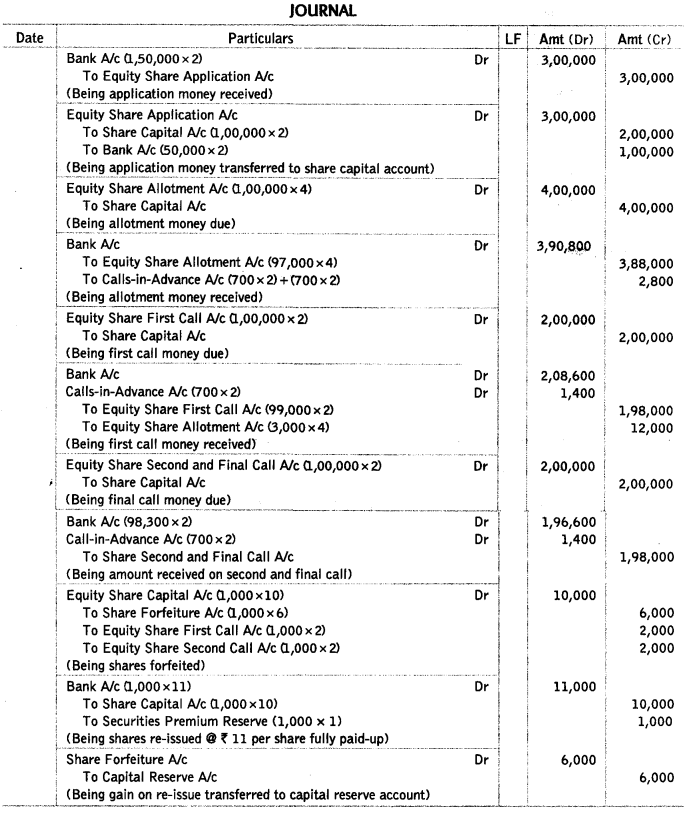
Question 93.
X Ltd invited applications for issuing 75,000 equity shares of ₹ 10 each at a premium of ₹ 5 per share. The amount was payable as follows
On application and allotment – ₹ 9 per share (including premium)
On first and final call – Balance amount
Applications for 3,00,000 shares were received. Applications for 2,00,000 shares were rejected and money refunded. Shares were allotted on pro-rata basis to the remaining applicants. The first and final call was made. The amount was duly received except on 1,500 shares applied by Ravi. His shares were forfeited. The forfeited shares were re-issued at a discount of ₹ 4 per share. Pass necessary journal entries for the above transactions in the books of X Ltd. (All India 2014)
Answer:
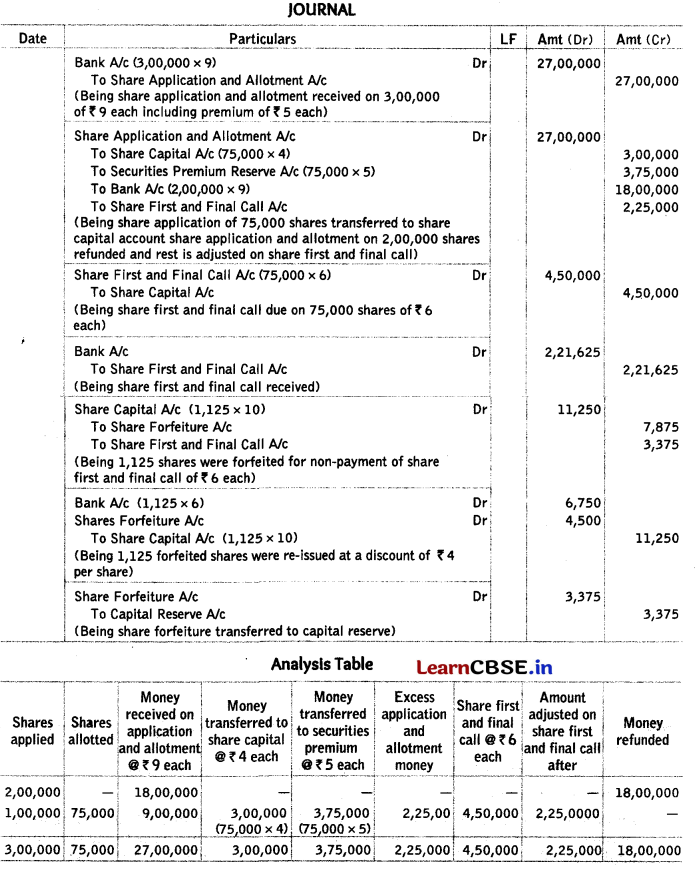
Working Notes:
Those who applied for 1,00,000 shares were allotted = 75,000 shares
Ravi who applied for 1,500 shares was allotted = 75,000 x \(\frac { 1500 }{ 100000 }\) = 1,125 shares
Share Application and Allotment received on 1,500 shares of ₹ 9 each
(including premium of 7 5 each) = 13,500
Shares allotted (1,125 x 9) = (10425)
Excess application and allotment money received = 3,375
Share first and final call due to 1,125 shares of ₹ 6 each = 6,750
Share first and final call not received = 3,375 (6,750 – 3,375)
Therefore, share first and final call received = 2,21,625 (2,25,000 – 3,375)
Question 94.
Bhagwati Ltd invited applications for issuing 2,00,000 equity shares of ₹ 10 each. The amounts were payable as follows
On application – ₹ 3 per share
On allotment – ₹ 5 per share
On first and final call – ₹ 2 per share
Applications were received for 3,00,000 shares and pro-rata allotment was made to all the applicants. Money overpaid on application was adjusted towards allotment. B, who was allotted 3,000 shares, failed to pay the first and final call money. His shares were forfeited. Out of the forfeited shares, 2,500 shares were re-issued as fully paid-up @ ₹ 8 per share.
Pass necessary journal entries to record the above transactions in the books of Bhagwati Ltd. (All India 2014)
Answer:
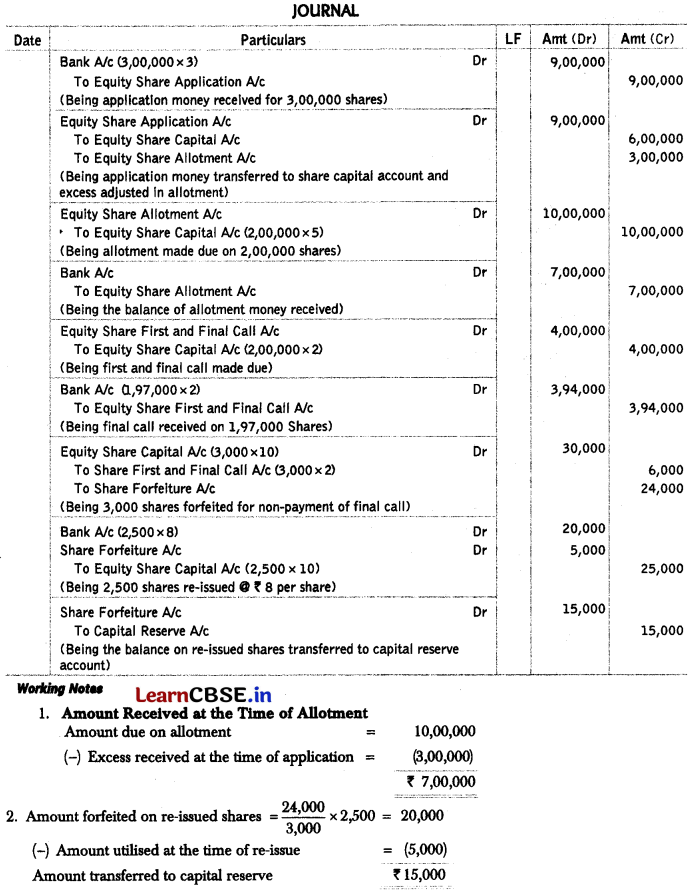
![]()
Question 95.
Record the journal entries for forfeiture and re-issue in the following cases
(i) X Ltd forfeited 200 shares of ₹ 100 each, ₹ 70 called-up, on which the shareholders had paid application and allotment money of ₹ 50 per share. Out of these, 150 shares were re-issued to Naresh as ₹ 70 paid-up for ₹ 80 per share.
(ii) Y Ltd forfeited 180 shares of ₹ 10 each, ₹ 8 called-up, issued at a premium of ₹ 2 per share to R for non-payment of allotment money of ₹ 5 per share (including premium). Out of these, 160 shares were re-issued to Sanjay as ₹ 8 called-up for ₹ 10 per share fully paid-up. (All India 2013)
Answer:
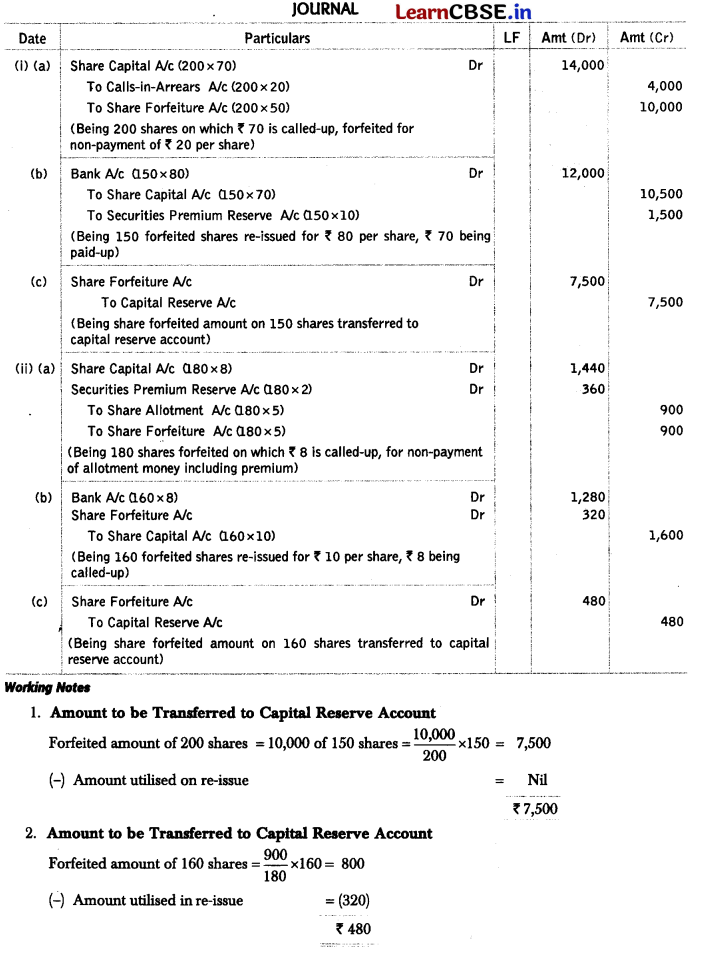
Question 96.
Record the journal entries for forfeiture and re-issue of shares in the following cases
(i) X Ltd forfeited 20 shares of ₹ 10 each, ₹ 7 called-up on which the shareholder had paid application and allotment money of ₹ 5 per share. Out of these, 15 shares were re-issued to Naresh as ₹ 7 per share paid-up for ₹ 8 per share.
(ii) Y Ltd forfeited 90 shares of ₹ 10 each, ₹ 8 called up issued at a premium of ₹ 2 per share to ‘R’ for non-payment of allotment money of ₹ 5 per share (including premium). Out of these, 80 shares were re-issued to Sanjay as ₹ 8 called-up for ₹ 10 per share. (Delhi 2013)
Answer:
Solve as Q. no. 49 on page 340 and 341.
(i) Capital Reserve = ₹ 75
(ii) Capital Reserve = ₹ 400
Question 97.
RK Ltd invited applications for issuing 70,000 equity shares of ₹ 10 each at a premium of ₹ 35 per share. The amount was payable as follows
On application – ₹ 15 per share (including ₹ 12 premium)
On allotment – ₹ 10 per share (including ₹ 8 premium)
On first and final call – Balance amount
Applications for 65,000 shares were received and allotment was made to all applicants. A shareholder Ram, who was allotted 2,000 shares, failed to pay the allotment money. His shares were forfeited immediately after allotment. Afterwards the first and final call was made. Sohan, who had 3,000 shares, failed to pay the first and final call. His shares were also forfeited. Out of the forfeited shares 4,000 shares were re-issued @ ₹ 50 per share fully paid-up. The re-issued shares included all the shares of Ram.
Pass necessary journal entries for the above transactions in the books of RK Ltd. (All India 2012)
Answer:
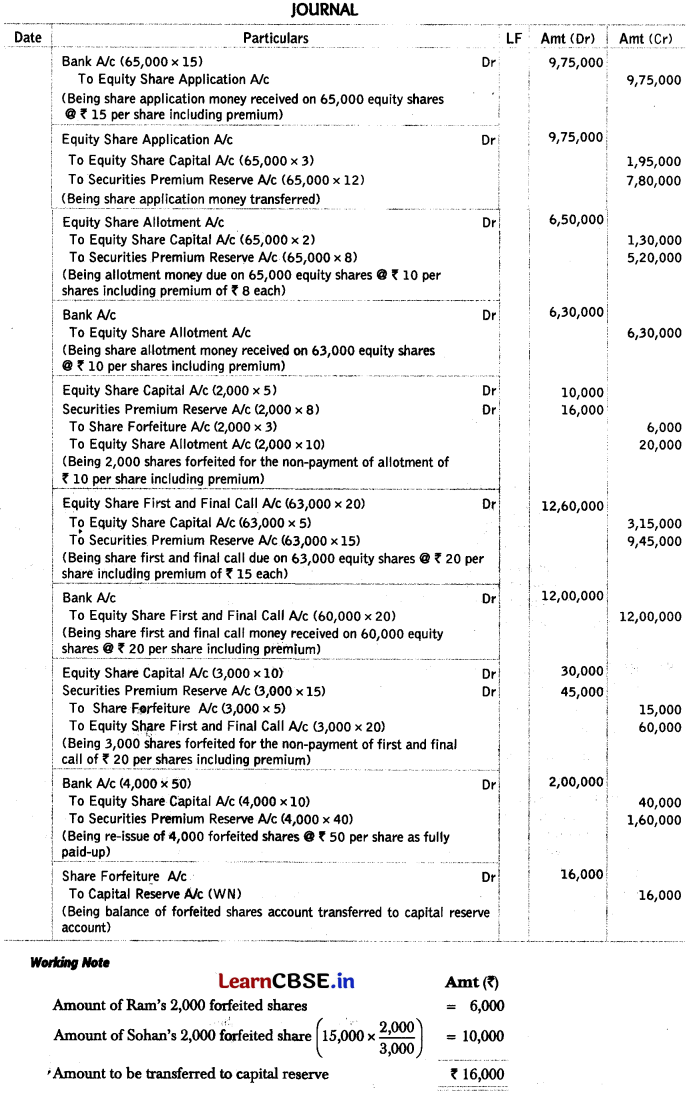
Question 98.
Shyam Ltd invited applications for issuing 80,000 equity shares of ₹ 10 each at a premium of ₹ 40 per share. The amount was payable as follows
On application – ₹ 35 per share (including ₹ 30 premium)
On allotment – ₹ 8 per share (including ₹ 4 premium)
On first and final call – Balance amount
Applications for 77,000 shares were received. Shares were allotted to all the applicants.
Sundram to whom 7,000 shares were allotted failed to pay the allotment money. His shares were forfeited immediately after allotment.
Afterwards the first and final call was made. Satyam, the holder of 500 shares failed to pay the first and final call. His shares were also forfeited. Out of the forfeited shares 1,000 shares were re-issued at ₹ 50 per share fully paid-up. The re-issued shares included all the shares of Satyam. Pass necessary journal entries for the above transactions in the books of Shyam Ltd. (Delhi 2012)
Answer:
Solve as Q no. 51 on page 341 and 342.
Capital Reserve = ₹ 7,000
Question 99.
Which category of shares are redeemed after a specific given period according to r the terms of issue?
(a) Cumulative preference shares
(b) Redeemable preference shares
(c) Irredeemable preference shares
(d) Non-cumulative preference shares
Answer:
(b) Redeemable preference shares
Question 100.
Capital reserve is the reserve which is not readily available for distribution of dividend. It is mandatory to create capital reserve in case of
(a) capital profits earned by the company
(b) loss generated by the company
(c) gain made by company
(d) None of the above
Answer:
(a) capital profits earned by the company
Question 101.
Shares offered to a specific group of people or to an organisation is called
(a) pubic issue
(b) public offer
(c) private placement
(d) None of these
Answer:
(c) private placement
Question 102.
ABC Ltd received application money on its issued share capital, which account is debited while recording this transaction?
(a) Share application account
(b) Balance sheet
(c) Bank account
(d) None of the above
Answer:
(c) Bank account
Question 103.
Shares issued for consideration other than cash are paid through
(a) cheque
(b) liability
(c) asset
(d) None of these
Answer:
(c) asset
Question 104.
A company issues shares for consideration other than cash at par. Which account will be debited while recording the issue of shares?
(a) Share capital account
(b) Share at par account
(c) Vendor
(d) Share premium account
Answer:
(c) Vendor
Question 105.
What is the maximum interest rate charged on call-in-arrears amount as per Company Act, 2013?
(a) 10%
(b) 12%
(c) 15%
(d) 7%
Answer:
(a) 10%
Question 106.
What interest rate is applicable on calls-in-advance amount as per Company Act, 2013?
(a) 10%
(b) 12%
(c) 15%
(d) 7%
Answer:
(b) 12%
Question 107.
A company may receive calls-in-advance, if it is permitted by its
(a) AoA
(b) MoA
(c) Both (a) and (b)
(d) None of these
Answer:
(a) AoA
![]()
Question 108.
On forfeiture, share capital is
(a) reduced
(b) increased
(c) no change
(d) Either (a) or (b)
Answer:
(a) reduced
Question 109.
When forfeited shares are re-issued at premium, then premium account is
(a) debited with share face value
(b) credited with share face value
(c) debited with premium amount
(d) credited with premium amount
Answer:
(d) credited with premium amount
Question 110.
When discount is allowed on re-issue of forfeited shares, then the amount of discount is calculated using the formula
(a) Number of shares re-issued × (Paid-up value per share – Re-issue price per share)
(b) Number of shares re-issued × Paid-up value
(c) Number of shares re-issued × Re-issue price per share
(d) Paid-up value × Re-iasuejniceper share
Answer:
(a) Number of shares re-issued × (Paid-up value per share – Re-issue price per share)
Question 111.
A Ltd forfeited 300 shares of 10 each, fully called-up, held by B for non-payment of allotment money of ₹ 3 per equity share and final call money of ₹ 4 per share. Out of these, 250 shares were re-issued to C for a total payment of ₹ 1,800. Calculate the amount to be transferred to capital reserve account?
(a) ₹ 750
(b) ₹ 50
(c) ₹ 700
(d) ₹ 900
Answer:
(b) ₹ 50